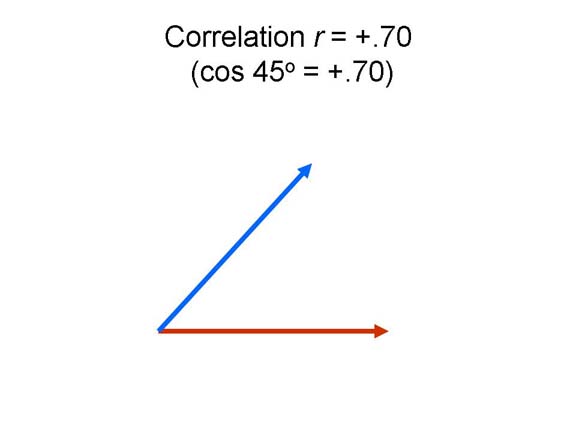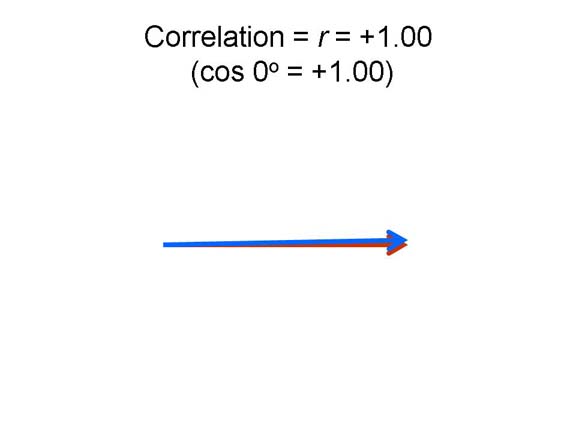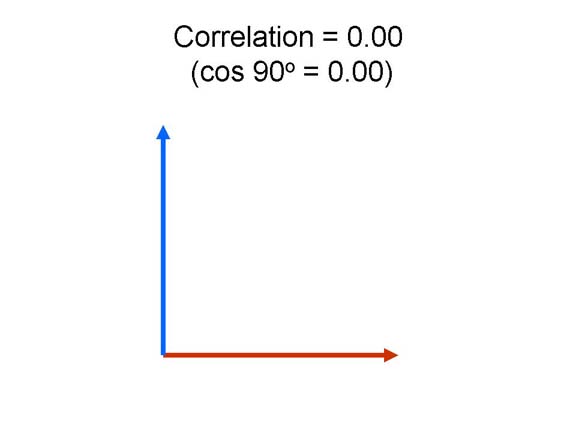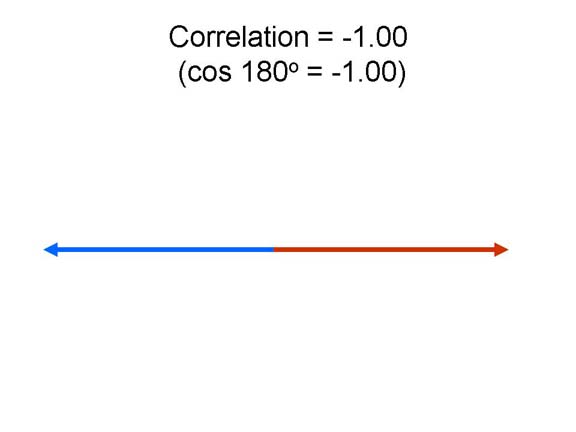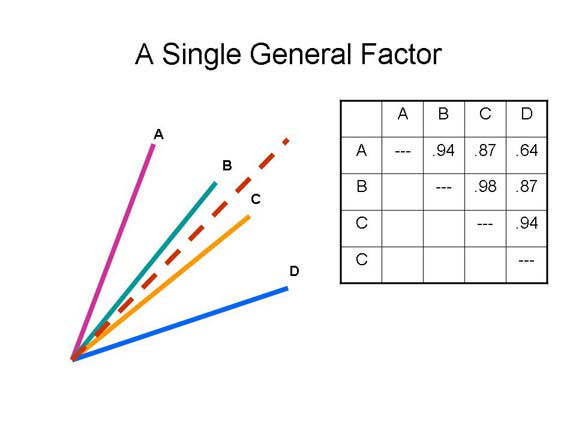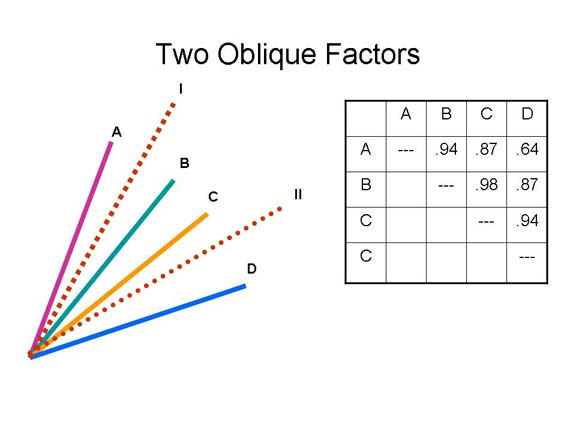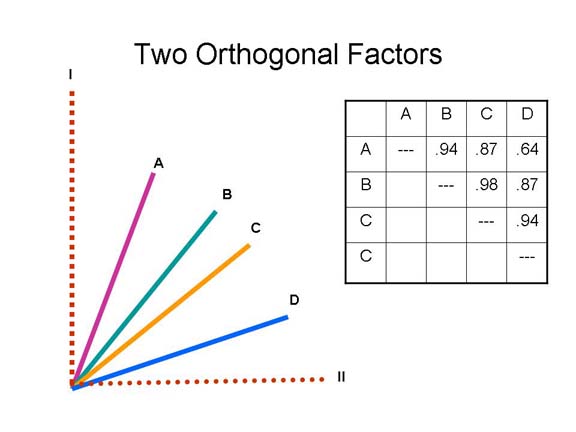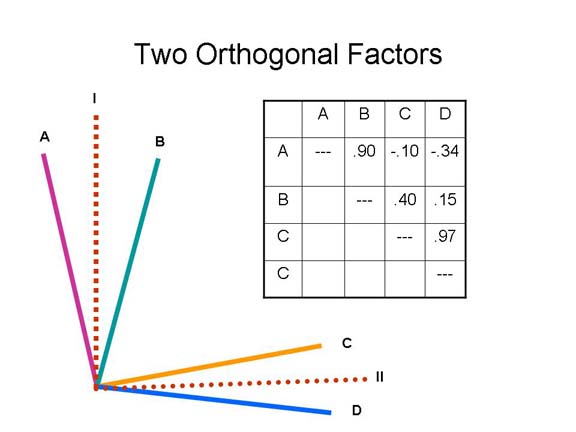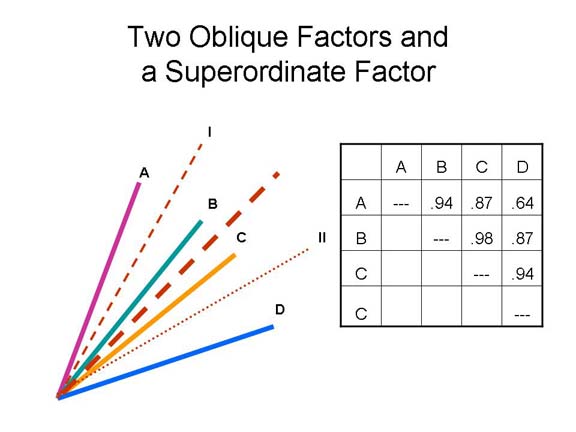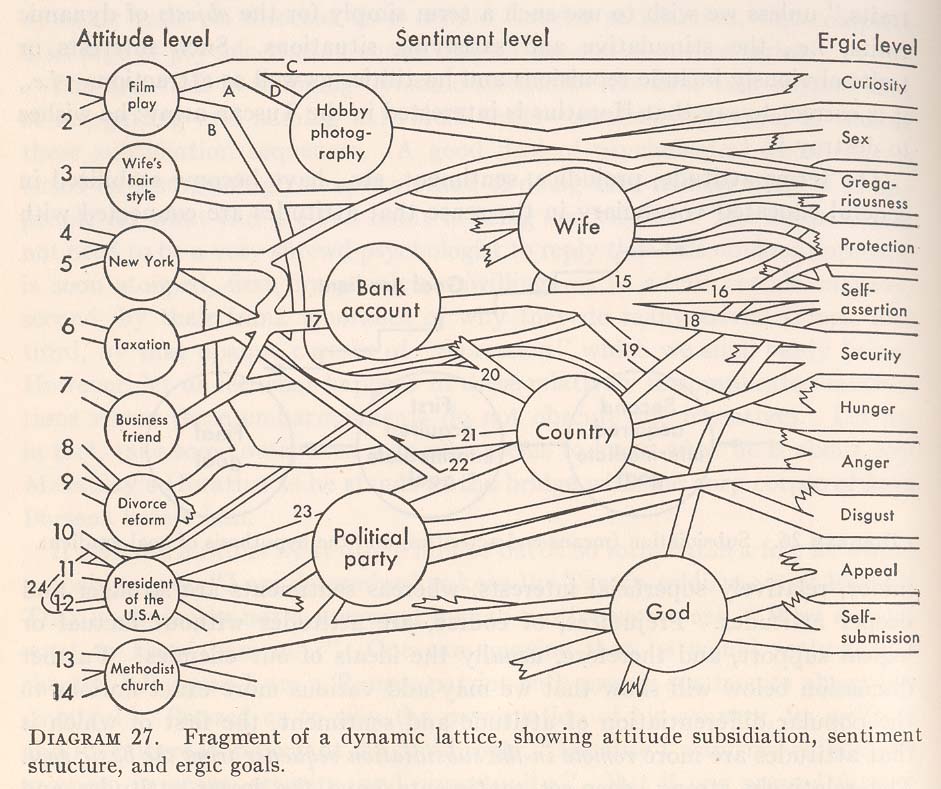Types and Traits
How do you describe another person? How do you capture the gist of his or her personality, showing how the person is like some other people without obscuring his or her uniqueness? Make no mistake about it: We do describe other people, all the time, in the course of our everyday living. Psychologists, novelists and short-story writers, and the public at large are constantly engaged in describing other people, in trying to articulate to themselves, and communicate to someone else, what another person is like. This activity is certainly as old as human language, and the scientific study of personality properly begins with a consideration of how such descriptive systems evolved.
In some cultures, such as the island of Bali in the South Pacific, the Oriya in India, and the Gahuku-Gama of New Guinea, people are described in terms of lists of specific actions which they perform in particular situational contexts (Shweder & Bourne, 1981). In America, however, and in Western culture generally, we tend to describe each other either with nouns designating whole classes of people (such as "extravert", "genius", "hippie", "preppie"), or with an adjective describing some salient feature of our personalities (such as "friendly", "intelligent", "drugged", or "smug"). The situation is a little more complicated than this, because many adjectives have corresponding noun forms and vice-versa, but in general we tend to attach context-free descriptive labels to other people. This preference in ordinary language is parallel to the scientific descriptions of personality produced by Western personology. This scientific taxonomy, in turn, has its roots in certain literary. forms which center on the description of people. In order to understand how this transpired, we begin at the beginnings of Western science and literature: the Greeks.
Theophrastus and the Characterological Tradition in Literature
The chief preoccupation of Greek science was with classification. Aristotle (384-322 B.C.), in his Historia Animalium provided a taxonomy, or classificatory scheme, for biological phenomena.
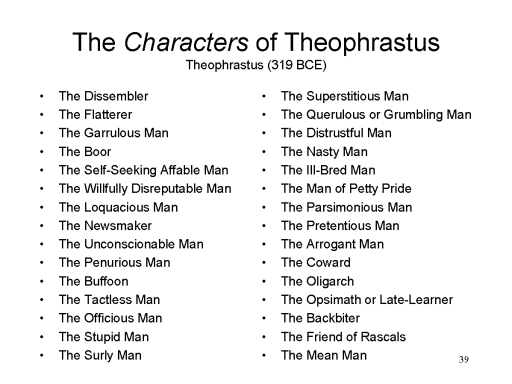 Theophrastus
(370-287 B.C.), his successor as head of the Peripatetic
School in Athens (so named because the teachers strolled
around the courtyard while lecturing), followed his example by
developing a taxonomy of people. His work is embodied in Characters,
a delightful book in which he described the various types of
people encountered in Athenian society. Unfortunately, that
portion of the book which described socially desirable types
has been lost to history: All that remains are his portraits
of 30 thoroughly negative characters, most of whom are
instantly recognizable even today, more than 2000 years later.
All his descriptions follow the same expository format: a
brief definition of the dominant feature of the personality
under consideration, followed by a list of typical behaviors
representative of that feature.
Theophrastus
(370-287 B.C.), his successor as head of the Peripatetic
School in Athens (so named because the teachers strolled
around the courtyard while lecturing), followed his example by
developing a taxonomy of people. His work is embodied in Characters,
a delightful book in which he described the various types of
people encountered in Athenian society. Unfortunately, that
portion of the book which described socially desirable types
has been lost to history: All that remains are his portraits
of 30 thoroughly negative characters, most of whom are
instantly recognizable even today, more than 2000 years later.
All his descriptions follow the same expository format: a
brief definition of the dominant feature of the personality
under consideration, followed by a list of typical behaviors
representative of that feature.
The Distrustful Man.It goes without saying that Distrustfulness is a presumption of dishonesty against all mankind; and the Distrustful man is he that will send one servant off to market and then another to learn what price he paid; and will carry his own money and sit down every furlong to count it over. When he is abed he will ask his wife if the coffer be locked and the cupboard sealed and the house-door bolted, and for all she may say Yes, he will himself rise naked and bare-foot from the blankets and light the candle and run round the house to see, and even so will hardly go to sleep. Those that owe him money find him demand the usury before witnesses, so that they shall never by any means deny that he has asked it. His cloak is put out to wash not where it will be fulled best, but where the fuller gives him good security. And when a neighbor comes a-borrowing drinking-cups he will refuse him if he can; should he perchance be a great friend or a kinsman, he will lend them, yet almost weigh them and assay them, if not take security for them, before he does so. When his servant attends him he is bidden go before and not behind, so that he may make sure he do not take himself off by the way. And to any man who has bought of him and says, 'Reckon it up and set it down; I cannot send for the money just yet,' he replies, 'Never mind; I will accompany you home' (Theophrastus, 319 B.C./1929, pp. 85-87).
Theophrastus initiated a literary tradition which became very popular during the 16th and 17th centuries, especially in England and France (for reviews see Aldington, 1925; Roback, 1928). However, these later examples represent significant departures from their forerunner. Theophrastus was interested in the objective description of broad types of people defined by some salient psychological characteristic. In contrast, the later efforts show an increasing interest in types defined by social class or occupational status. In other instances, the author presents word portraits of particular. individuals, with little apparent concern with whether the subjects of the sketch are representative of any broader class at all. Early examples of this tendency are to be found in the descriptions of the pilgrims in Chaucer's (c. 1387) Canterbury Tales. Two examples that lie closer to Theophrastus' intentions are the Microcosmographie of John Earle (1628) and La Bruyere's Les Caracteres (1688). More recent examples of the form may be found in George Eliot's Impressions of Theophrastus Such (1879) and Earwitness: Fifty Characters (1982) by Elias Canetti, winner of the 1981 Nobel Prize for Literature.
The later character sketches also became increasingly opinionated in nature, including the author's personal evaluations of the class or individual, or serving as vehicles for making ethical or moral points. Like Theophrastus, however, all of these authors attempted highly abstract character portraits, in which individuals were lifted out of the social and temporal context in which their lives ran their course. Reading one of these sketches we have little or no idea what forces impinged on these individuals to shape their thoughts and actions; what their motives, goals, and intentions were; or what their lives were like from day to day, year to year. As authors became more and more interested in such matters they began to write "histories" or "biographies" of fictitious characters -- in short, novels. In the 18th century the novel quickly rose to a position as the dominant literary form in Europe, and interest in the character-sketch waned. Character portraits still occur in novels and short stories, but only as a minor part of the whole -- perhaps contributing to the backdrop against which the action of the plot takes place. Again, insofar as they describe particular individuals, character sketches imbedded in novels lack the quality of universality which Theophrastus sought to achieve.
Scientific and Pseudoscientific Typologies in the Ancient World
Characters is a classic of literature because -- despite the radical differences between ancient Athenian culture and our own -- Theophrastus' 30 character types are instantly recognizable by readers of any place and time. As a scientific endeavor, however, it is not so satisfying. In the first place, Theophrastus provides no evidence in support of his typological distinctions: were there really 30 negative types of Greeks, or were there 28 or 32; and if there were indeed 30 such types, were they these 30? Moreover, Theophrastus did not offer any scheme to organize these types, showing how they might be related to each other. Perhaps more important -- assuming that Characters attained classic status precisely because Theophrastus' types were deemed to be universal -- is the question of the origin of the types. Theophrastus raised this question at the very beginning of his book, but he did not offer any answer:
I have often marvelled, when I have given the matter my attention, and it may be I shall never cease to marvel, why it has come about that, albeit the whole of Greece lies in the same clime and all Greeks have a like upbringing, we have not the same constitution of character (319 B.C./1929, p. 37).
The ancients had solutions to all problems, both scientific and pseudoscientific.
Astrology
Some popular approaches to creating typologies of personality have their origins in ancient folklore, and from time to time they have been endowed with the appearance of science. For example, a tradition of physiognomy diagnosed personality on the basis of similarities in physical appearance between individual humans and. species of infrahuman animals. Thus, a person possessing hawk-like eyes, or an eagle-like nose was presumed to share behavioral characteristics with that species as well.
By far the most prominent of these pseudoscientific approaches to personality was (and still is) astrology, which holds that the sun, moon, planets, and stars somehow influence. events on earth. The theory has its origins in the ancient idea that events in the heavens -- eclipses, conjunctions of stars, and the like -- were omens of things to come. This interest in astral omens has been traced back almost 4000 years. to the First Dynasty of the kingdom of Babylon. Astrology per se appears to have begun in the 3rd century B.C., when religious authorities began using the planets to predict events in an individual's life. The various planets, and signs of the Zodiac, were thought to be associated with various attributes. The astrologer prepared a horoscope, or map of the heavens at the moment of an individual's birth (or, sometimes, his or her conception), and predicted on the basis of the relative positions of the heavenly bodies what characteristics the person would possess. Of course, because these relative positions varied constantly, somewhat different predictions could be derived for each individual. To the extent that two individuals were born at the same time and in the same place, then, they would be similar in personality.
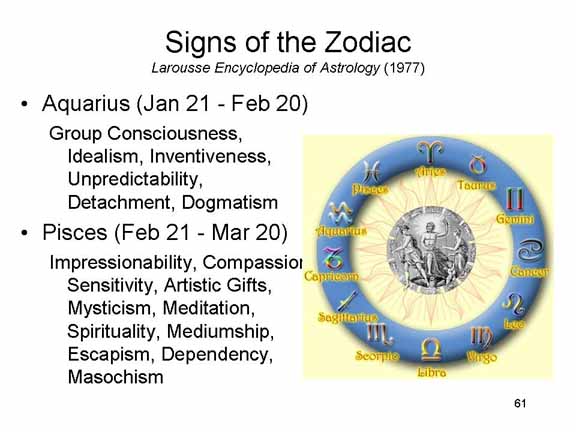
-
Aries is essentially a sign of beginnings, of boundless creativity and pure energy. Arians ... must be up and doing for the sheer joy of it, especially if the activity involves adventure, the exploration of unknown territory, and even danger. The rulership of Mars bestows strength and courage, and a strong desire nature, which means both sexual desire and the drive to conquer and possess material things, power, and fame. The incredible Aries energy in initiating new projects is a blend of the enthusiasm and self-confidence of fire and the outgoing activity of cardinality. The polar opposite of indecisive Libra, Arians seldom have time to look before they leap; they simply rush forward headlong, for it is their business to lead and inspire.
-
The symbol for Scorpio is the scorpion, a creature that travels by night and is feared for its deadly sting. Though all Scorpio people are by no means venomous and cruel, the symbol conveys the qualities of secretiveness, penetration, and power that do characterize the natives of this sign .... Besides the strong sexuality for which they are famous, Scorpio people also have an awareness of death that is often not fearful .... Indeed, if they are afraid of anything at all, it is of being known as deeply as they wish to know. Their ability to penetrate and probe may be channeled constructively into research or healing or it may be used to manipulate people in personal relationships.
Astrology was immensely powerful in the ancient world, and even in this century various political leaders such as Adolph Hitler in Germany and Lon Nol in Cambodia have computed horoscopes to help them in decision-making. However, by the 17th century astrology had lost its theoretical underpinnings. First, the new astronomy of Copernicus (1473-1543), Galileo (1564-1642), and Kepler (1571-1630), showed that the earth was not at the center of the universe, as astrological doctrine required. Then, the new physics of Descartes (1596-1650) and Newton (1642-1727) proved that the stars could have no physical influence on the earth. If that were not enough, the more recent discovery of Uranus, Neptune, and Pluto would have created enormous problems for a system that was predicated on the assumption that there were six, not nine, planets. In any event, there is no credible evidence of any lawful relationship between horoscope and personality.
And even if it were, it wouldn't be a matter of the position of the planets causing individual differences in personality. More likely, any such effect would be mediated by what Robert K. Merton (1949) called a self-fulfilling prophecy. That is, people who believe that Scorpios are secretive may treat such individuals in a way that makes them secretive.
The Humour Theory of Temperament
Greek science had another answer for these questions, in the form of a theory first proposed by Hippocrates (460?-377? B.C.), usually acknowledged as the founder of Western medicine, and Galen (130-200? A.D.), a Roman physician who was his intellectual heir. Greek physics asserted that the universe was composed of four cosmic elements: air, earth, fire, and water. Human beings, as microcosms of nature, were composed of four corresponding humors -- biological substances which paralleled the cosmic elements. The predominance of one humor over the others endowed each individual with a particular type of temperament.
The cosmic elements, their corresponding humors, and the resulting temperamental types are given in the following table:
Cosmic Element |
Bodily Humour |
Temperament |
Air |
Blood |
Sanguine |
Earth |
Black Bile |
Melancholic |
Fire |
Yellow Bile |
Choleric |
Water |
Phlegm |
Phlegmatic |
Humor theory was the first scientific theory of personality -- the first to base its descriptions on some basis other than the personal predilections of the observer, and the first to provide a rational explanation of individual differences. The theory was extremely powerful, and dominated both philosophical and medical discussions of personality well into the 19th century.
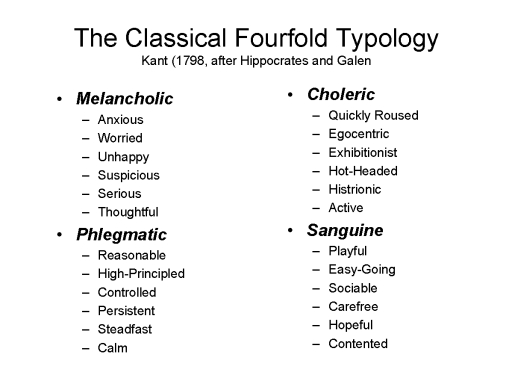 Immanuel Kant, the German philosopher, abandoned Greek humor
theory but retained its fourfold classification of personality
types in his Anthropology (1798). His descriptions of
the four personality types have a flavor strongly reminiscent
of Theophrastus'Characters.
Immanuel Kant, the German philosopher, abandoned Greek humor
theory but retained its fourfold classification of personality
types in his Anthropology (1798). His descriptions of
the four personality types have a flavor strongly reminiscent
of Theophrastus'Characters.
-
The Sanguine Temperament. The sanguine person is carefree and full of hope; attributes great importance to whatever he may be dealing with at the moment, but may have forgotten all about it the next. He means to keep his promises but fails to do so because he never considered deeply enough beforehand whether he would be able to keep them. He is good-natured enough to help others, but is a bad debtor and constantly asks for time to pay. He is very sociable, given to pranks, contented, doesn't take anything very seriously and has many, many friends. He is not vicious, but difficult to convert from his sins; he may repent, but contrition (which never becomes a feeling of guilt) is soon forgotten. He is easily fatigued and bored by work, but is constantly engaged in mere games -- these carry with them constant change, and persistence is not his forte.
-
The Melancholic Temperament. People tending toward melancholia attribute great importance to everything that concerns them. They discover everywhere cause for anxiety, and notice first of all the difficulties in a situation, in contradistinction to the sanguine person. They do not make promises easily, because they insist on keeping their word, and have to consider whether they will be able to do so. Al this is so not because of moral considerations, but because interaction with others makes them worried, suspicious, and thoughtful; it is for this reason that happiness escapes them.
-
The Choleric Temperament. He is said to be hot-headed, is quickly roused, but easily calmed down if his opponent gives in; he is annoyed without lasting hatred. Activity is quick, but not persistent. He is busy, but does not like to be in business, precisely because he is not persistent; he prefers to give orders, but does not want to be bothered with carrying them out. He loves open recognition, and wants to be publicly praised. He loves appearances, pomp, and formality; he is full of pride and self-love. He is miserly; polite, but with ceremony; he suffers most through the refusal of others to fall in which his pretensions. In one word, the choleric temperament is the least happy, because it is the most likely to call forth opposition to itself.
-
The Phlegmatic Temperament. Phlegma means lack of emotion, not laziness; it implies the tendency. to be moved, neither quickly nor easily, but persistently. Such a person warms up slowly, but he retains the warmth longer. He acts on principle, not by instinct; his happy temperament may supply the lack of sagacity and wisdom. He is reasonable in his dealing with other people, and usually gets his way by persisting in objectives while appearing to give way to others.
In the end, Greek humor theory proved to be no more valid that astrology: it was an early victim of the scientific revolution of the 16th and 17th centuries. Nevertheless, it formed the basis for the study of the psychophysiological correlates of emotion -- the search for patterns of somatic activity uniquely corresponding to emotional experiences. Moreover, the classic fourfold typology laid the basis for a major tradition in the scientific study of personality, which emerged around the turn of the 20th century. We shall examine each of these topics in detail later. First, however, we should examine other typological schemes that are prominent today.
The Four Temperaments
For a history of the humour theory of temperament in medicine and psychology, see Passions and Tempers: A History of the Humours by Noga Arikha (Ecco/HarperCollins, 2007; reviewed by Sherwin P. Nuland in the New York Times Book Review, 07/08/2007).
 The
classic fourfold typology, derived from ancient Greek humour
theory, is often referred to as The Four Temperaments.
Under that label, it has been the subject of a number of
artworks. In Christ Crowned with Thorns (c.1479,
also called the Mocking of Christ), Jesus is
tormented by four men who represent the four temperaments:
clockwise from the upper left, choleric, sanguine,
phlegmatic, and melancholic.
The
classic fourfold typology, derived from ancient Greek humour
theory, is often referred to as The Four Temperaments.
Under that label, it has been the subject of a number of
artworks. In Christ Crowned with Thorns (c.1479,
also called the Mocking of Christ), Jesus is
tormented by four men who represent the four temperaments:
clockwise from the upper left, choleric, sanguine,
phlegmatic, and melancholic.
In music, a humoresque is a term given to a light-hearted musical composition. But Robert Schumann's "Humoreske in Bb",Op. 20 (1839), is a suite based on the four classical humours.
The German composer Paul Hindemith also wrote a suite for piano and strings -- a actually, a theme with four variations -- entitled The Four Temperaments (1940), which was choreographed for the Ballet Society, the forerunner of the New York City Center Ballet by George Balanchine (1946).
Modern Clinical Typologies
With the emergence of psychology as a scientific discipline separate from philosophy and physiology in the late 19th century, a number of other typological schemes were proposed. Most of these had their origins in astute clinical observation by psychiatrists and clinical psychologists rather than in rigorous empirical research. However, all of these were explicitly scientific in intent, in that their proponents attempted to develop a body of evidence that would confirm the existence of the types.
Freud
Sigmund Freud (1908), a Viennese psychiatrist whose theory of personality we will consider later in some detail (see "Freud's Psychoanalytic Theory"), claimed that adults displayed constellations of attributes whose origins could be traced to early childhood experiences related to weaning, toilet training, and sexuality. Freud himself described only one type -- the anal character, which displays excessive frugality, parsimony, petulance, obstinacy, pedantry, and orderliness.
Freud's followers, working along the same lines, elaborated a wide variety of additional types such as the oral, urethral, phallic, and genital (Blum, 1953; Fenichel, 1945; Shapiro, 1965). Here are some examples:
-
The Oral Character. The oral character ... is extremely dependent on others for the maintenance of his self-esteem. External supplies are all- important to him, and he yearns for them passively .... When he feels depressed, he eats to overcome the emotion. Oral preoccupations, in addition to food, frequently revolve around drinking, smoking, and kissing (Blum, 1953, p. 160).
-
The Urethral Character. The outstanding personality features of the urethral character are ambition and competitiveness ... (Blum, 1953, p. 163).
-
The Phallic Character. The phallic character behaves in a reckless, resolute, and self-assured fashion ....The overvaluation of the penis and its confusion with the whole body ... are reflected by intense vanity, exhibitionism, and sensitiveness .... These individuals usually anticipate an expected assault by attacking first. They appear aggressive and provocative, not so much from what they say or do, but rather in their manner of speaking and acting. Wounded pride ... often results in either cold reserve, deep depression, or lively aggression (Blum, 1953, p. 163).
Jung
C.G. Jung (1921), an early follower of Freud, developed an eightfold typology constructed from two attitudes and four functions. In Jung's system, the attitudes represented different orientations toward the world: the extravert, concerned with other people and objects; and the introvert, concerned with his or her own feelings and experiences. The functions represented different was of experiencing the objects of the attitude: thinking, in which the person was engaged in classifying observations and organizing concepts; feeling, in which the person attached values to observations and ideas; sensing, in which the person was overwhelmingly concerned with concrete facts; and intuition, in which the person favored the immediate grasping of an idea as a whole.
The typical opposition I have described is characteristic of the introverted and extraverted attitudes. The first, if normal, is revealed by a hesitating, reflective, reticent disposition, that does not easily give itself away, that shrinks from objects, always assuming the defensive, and preferring to make its cautious observations from a hiding-place. The second type, if normal, is characterized by an accommodating, and apparently open and ready disposition, at ease in any given situation. This type forms attachments easily, and ventures, unconcerned and confident, into unknown situations, rejecting thoughts of possible contingencies. In the former case, manifestly the subject, in the latter, the object, is the decisive factor (Jung, 1917).
The four functional types correspond to the obvious means by which consciousness obtains its orientation. Sensation, sense perception, tells us that something exists; thinking tells you what it is; feeling tells you whether it is agreeable or not; and intuition tells you whence it comes and where it is going (Jung, 1917).
In each person, one attitude and one function dominated over the others, resulting in eight distinct personality types. These attitudes and functions, inferred by Jung on the basis of his clinical observations, may be measured by a specialized psychological test, the Myers-Briggs Type Indicator (MBTI; Myers, 1962).
Functions |
Attitudes |
|
Introverted |
Extraverted |
|
Sensing |
||
Thinking |
||
Feeling |
||
Intuiting |
||
A note of caution: the MBTI is very popular among human-resource managers, and on self-discovery and self-help websites, but it isn't a very good personality inventory. For example, although "types" are supposed to be permanent, even innate, people's scores on the MBTI can vary widely if taken on more than one occasion. For more on the history, use, and validity of the MBTI, see The Personality Brokers by Merve Emre (2018) and The Cult of Personality Testing" by Annie Murphy Paul (2004). Also "Can You Type?" by Louis Menand, New Yorker, 09/10/2018.
Sheldon
Another important typology was developed by Sheldon (1940,1942), as an extension of the constitutional psychology introduced by the German psychiatrist, Ernst Kretchmer (1921). Kretchmer and Sheldon both asserted that there was a link between physique and personality.
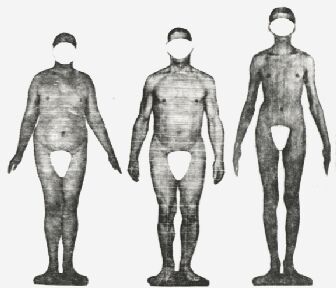 On the basis of his anthropometric studies of the bodily
builds, in which he took various measurements of the head,
neck, chest, trunk, arms, legs, and other parts of the body,
Sheldon discerned three types of physique reflecting both the
individual's constitutional endowment and his or her current
physical appearance:
On the basis of his anthropometric studies of the bodily
builds, in which he took various measurements of the head,
neck, chest, trunk, arms, legs, and other parts of the body,
Sheldon discerned three types of physique reflecting both the
individual's constitutional endowment and his or her current
physical appearance:
-
endomorphs possessed soft, round features;
-
mesomorphs were hard and rectangular in appearance; and
-
ectomorphs were thin and fragile.
In his Atlas of Men (1954), Sheldon introduced a procedure by which people could be categorized based on ratings of endomorphy, mesomorphy, and ectomorphy. As you might expect, Sheldon also planned to produce an Atlas of Women, as well as an Atlas of Children, but both projects were unfinished at the time of his death.
On the basis of personality data, including questionnaires and clinical interviews, Sheldon likewise discerned three types of temperament:
-
viscerotonia, featuring sociability and tolerance;
-
somatotonia, featuring physical vigor and adverturesomeness; and
-
cerebrotonia, featuring restraint and self-consciousness.
Sheldon also found a relationship between the physical and psychological typologies:
-
endomorphs tended toward viscerotonia,
-
mesomorphs toward somatotonia, and
-
ectomorphs toward cerebrotonia.
Sheldon felt that this relationship reflected the common genetic and biochemical determinants of both physique and temperament, though of course the relationship could also reflect common environmental sources. For example, one's physique may place some limits on the kinds of activities in which one engages; or, alternatively, social stereotyping may limit the kinds of activities in which people with certain physiques are involved.
Actually, it turns out that the relationship is a lot simpler than that. It turns out that Sheldon's raters (who included Sheldon himself) were not blind to his theory. They knew that Sheldon had hypothesized that endomorphs tended to be viscertonic (not to mention that the stereotype of the jolly fat person has been around for a long time). And there is every reason that they saw what they were supposed to see. The fact that Sheldon's raters weren't blind obviates the whole research enterprise, and so you wonder why they even bothered doing the study. It's of interest to note that Sheldon did his studies on undergraduates in the "Ivy League" and "Seven Sisters" schools, based on the infamous "posture photographs" that these schools during freshman orientation week (see"The Great Ivy League Nude Posture Photo Scandal" by Ron Rosenbaum,New York Times Magazine, 01/15/1995).You can't help but wonder whether the whole enterprise was little more than an excuse to look at pictures of college students in their underwear (or less!).
Horney
Another follower of Freud, Karen Horney (in Our Inner Conflicts, 1945), proposed a three-category system based on characteristic responses of the developing child to feelings of helplessness and anxiety.
-
The compliant type fears rejection and criticism, needs, affection and approval, and subordinates him- or herself to others.
-
The aggressive type sees affection, sympathy, and trust as signs of weakness, and seeks mastery, domination, and self- glorification.
-
The detached type fears the obligations and influences that come with ordinary social relations, and thus avoids situations involving. competition and intimacy.
Sociological Typologies
Other typological systems have resulted from the analysis of whole societies rather than of individual clinic patients. Although sociology is an empirical science, these typologies are not. typically determined quantitatively. Rather, like their clinical counterparts, they represent the investigator's intuitions about the kinds of people who inhabit a particular culture.
Spranger
The German philosopher and psychologist Eduard Spranger did not, strictly speaking, postulate a typology. Rather, he was interested in describing various coherent sets of values which a person could use to guide his or her life. However, the argument was presented in a book entitled Types of Men (1914/1928), so the descriptions below (as summarized by Allport & Vernon, 1931), seem to fit our purposes.
1. The Theoretical. The dominant interest of the theoretical man is the discovery of truth. In the pursuit of this goal he characteristically takes a "cognitive" attitude, one that looks for identities and differences; one that divests itself of judgments regarding the beauty or utility. of objects, and seeks only to observe and to reason .... His chief aim in life is to order and to systematize his knowledge.
2. The Economic. The economic man is characteristically interested in what is useful. Based originally upon the satisfaction of bodily needs (self-preservation), the interest in utilities develops to embrace the practical affairs of the business world -- the production, marketing, and consumption of goods, the elaboration of credit, and the accumulation of tangible wealth. This type is thoroughly "practical" ....
3. The Esthetic. The esthetic man sees his highest value in form and harmony. Each single experience is judged from the standpoint of grace, symmetry, or fitness. He regards life as a manifold of events; each single impression is enjoyed for its own sake. He need not be a creative artist; nor need he be effete; he is esthetic if he but finds his chief interest in the artistic episodes of life ....
4. The Social. The highest value for this type is love of people, whether of one or many, whether conjugal, filial, friendly, or philanthropic. The social man prizes other persons as ends, and is therefore himself kind, sympathetic, and unselfish. He is likely to find the theoretical, economic, and esthetic attitudes cold and inhuman. In contrast to the political type, the social man regards love as itself the only suitable form of power, or else repudiates the entire conception of power as endangering the integrity of personality. In its purest form the social interest is selfless and tends to approach very closely to the religious attitude.
5. The Political. The political man is interested primarily in power. His activities are not necessarily within the narrow field of politics; but whatever his vocation be betrays himself as a Machtmensch. Leaders in any field generally have high power value. Since competition and struggle play a large part in all life, many philosophers have seen power as the most fundamental of motives ..... There are, however, certain personalities in whom the desire for a direct expression of this motive is uppermost, who wish above all else for personal power, influence, and renown.
6. The Religious. The highest value for the religious man may be called unity. He is mystical, and seeks to comprehend the cosmos as a whole, to relate himself to its embracing totality .... Some men of this type are "immanent mystics", that is, they find in the affirmation of life and in active participation therein their religious experience. A Faust with his zest and enthusiasm sees something divine in every event. The "transcendental mystic", on the other hand, seeks to unite himself with a higher reality by withdrawing from life; he is the escetic, and like the holy men of India, finds the experience of unity through self-denial and meditation.
Spranger's work formed the basis for an assessment of individual differences in human values by Allport and Vernon (1931; see also Allport, Vernon, & Lindzey, 1970).
Riesman
In one of the most influential pieces of social criticism written since World War II, David Riesman's the Lonely Crowd (1950) analyzed the impact of industrial development on personality.
-
The members of underdeveloped societies, especially if literacy was not widespread, tended to be tradition-directed. Such people define themselves in terms of age, clan, or caste, and adhere to longstanding patterns of behavior rather than seeking new solutions to the problems which they face.
-
As societies begin to mature and the quality of life improves through agricultural and industrial development, the individual is confronted by opportunities for upward mobility, and a wide range of choices concerning his or her vocation. The inner-directed individual is able to cope with these new alternatives, even in the absence of traditional institutions, because he or she has internalized goals set by his or her parents.
-
At some point, agricultural and industrial development reach such a point that the members of a society accumulate both a fair amount of wealth and a substantial share of leisure time; service industries begin to supplant production.; Under these conditions, a "new middle class" emerges which may be characterized as other-directed. For these individuals, choices and goals are determined by other people, and especially the media, rather than by their families or traditional institutions. Note that tradition-, inner-, and other-directed people are not different in conformity; rather, they are different in terms of what they conform to.
Riesman argued that the other-directed type predominated in postwar American society. But to the extent that economic and cultural conditions vary in a pluralistic society, we might still expect to find a fair representation of the other types as well.
Fromm
Fromm, who was as much influenced by Karl Marx as by Sigmund Freud, and by economics as much as by psychopathology, offered a list of five basic character types, which result from differential socialization rather than from childhood anxieties.
-
The receptive type feels inferior and insignificant, and acquiesces out of a fear of others.
-
The exploitative type also feels weak and helpless, and tries to gain advantage over others by force and cunning.
-
The hoarding type fears competition and the threats that come with it, and seeks security by refusing to share with others.
-
The marketing type lacks originality and self-confidence, and tries to conform to the expectations of others.
These types of adjustment are labeled "unproductive" by Fromm, because they prevent the individual from realizing his or her full potential.
-
The productive type, by contrast, uses these nonproductive strategies in productive ways -- transforming receptivity into friendliness, hoarding into conscientiousness, etc. -- and uses them to enjoy a life in which he or she is creative, concerned for others, capable of loving and capable of being loved
From Types to Traits
The typologies of Theophrastus and his successors -- Jung, Sheldon, Reisman, and others -- are satisfying from one standpoint, because they seem to capture the gist of many of the people whom we encounter in our everyday lives. However, from a scientific point of view they are unsatisfying on at least two counts.
First, it is hard to specify the rules by which the various type. concepts have been defined. According to the classical view of categorization which has dominated typological thinking since the time of Aristotle, concepts label proper sets of attributes which are single necessary and jointly sufficient to define some category. Each of these defining attributes must be present in every instance, giving the category an "all-or-none" quality. Thus, for example, a triangle is defined as a closed figure with three sides and three angles. Either each feature is present or it is not. Any geometrical form which possesses all of these properties is a triangle; any figure which lacks even one of them is not. Proper sets may be arranged in a hierarchy based on class inclusion relations, in which subcategories ma be formed by adding on new defining features. Thus, the superordinate category "geometrical figure" may be divided. into "points" (having no dimensions), "lines" (having only one dimension), "planes" (having two dimensions), and "solids" (having three dimensions). Shapes may be divided into triangles, quadrilaterals, and the like. Triangles may be divided into equilateral or isosceles, right or acute; quadrilaterals can be divided into parallelograms, rhombuses, trapezoids, and trapeziums; etc. Such hierarchies show perfect nesting: all instances of subcategories also possess the defining features of. the relevant superordinate category.
Such an approach works well for geometrical patterns, but applying it to people presents a number of different problems. First, human attributes are not generally present in an all-or-none manner, but are continuously distributed over an infinite series of gradations. The most prominent exceptions are gender and blood type; but the claim of continuity holds true for other strictly physical dimensions such as height, girth, and skin color -- How tall is tall? How fat is fat? How black is black? -- and this is all the more the case for psychological attributes. All sanguines may be sociable, but some people are more sociable than others. The notion that some people may be more sanguine than others, which is what this fact implies, is inconsistent with the classical view of categorization. Moreover, many individuals display the features of contrasting categories. If sanguines are sociable, and cholerics egocentric, what do we make of a person who is both sociable and egocentric? We are reminded of the entomologist who found an insect which he could not classify, and promptly stepped on it. The problem of partial and combined expression of type features, once recognized and taken seriously, was the beginning of the end for type theories.
A second problem has to do with the sheer number of different typological schemes that have been proposed. Most of these typologies are eminently plausible: each of us knows some extraverts and some sanguines, thinkers and intuiters, somatotonics and other-directed people. The reader who has stuck with this chapter so far may also have discovered that some (perhaps many or most) of his or her acquaintances can be classified into several different type categories, depending on which features are the focus of attention. This puts us in the curious position that a person's type can change. according to the mental set of the observer, even if his or her behavior has not changed at all. As Allport (1937) noted, no typology can encompass all the attributes of a person:
Whatever the kind, a typology is always a device for exalting its author's special interest at the expense of the individuality of the life which he ruthlessly dismembers .... This harsh judgment is unavoidable in the face of conflicting typologies. Certainly not one of these typologies, so diverse in conception and scope, can be considered final, for none of them overlaps any other. Each theorist slices nature in any way he chooses, and finds only his own cuttings worthy of admiration .... What has happened to the individual? He is tossed from type to type, landing sometime in one compartment and sometime in another, often in none at all (p. 296).
As this passage makes clear, Allport's objection to typologies was that they are biosocial rather than biophysical in nature. He held that types are cognitive categories rather than attributes of people: they exist in the minds of observers rather than in the personalities of the people who are observed. For Allport, as for many other personologists who wish to base a theory of personality on how individuals differ in essence, types appear. to be a step in the wrong direction.
The Dimensional Solution
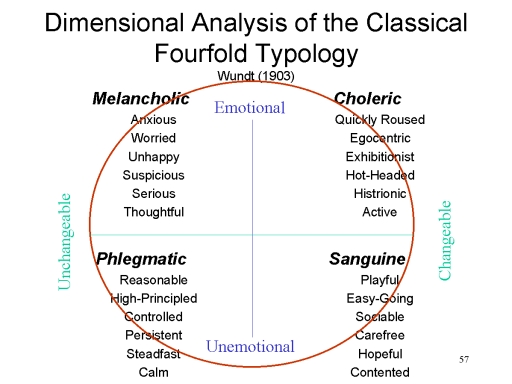 One of
the founders of modern scientific psychology, Wilhelm Wundt
(1903), offered a solution to both these dilemmas. Wundt was a
structuralist, primarily concerned with analyzing mental life
into its basic elements. While his work emphasized the
analysis of sensory experience, he also turned his attention
to the problems of emotion and personality. Wundt argued that
the classic fourfold typology of Hippocrates, Galen, and Kant
could be understood in terms of emotional arousal.
One of
the founders of modern scientific psychology, Wilhelm Wundt
(1903), offered a solution to both these dilemmas. Wundt was a
structuralist, primarily concerned with analyzing mental life
into its basic elements. While his work emphasized the
analysis of sensory experience, he also turned his attention
to the problems of emotion and personality. Wundt argued that
the classic fourfold typology of Hippocrates, Galen, and Kant
could be understood in terms of emotional arousal.
-
Cholerics and melancholics were disposed to strong emotions, while sanguines and phlegmatics were disposed to weak ones.
-
Similarly, the emotions were quickly aroused in cholerics and sanguines, but only slowly in melancholics and phlegmatics.
Instead of slotting people into four discrete categories, Wundt proposed that people be classified in terms of two continuous dimensions reflecting their characteristic speed and intensity of emotional arousal. In this way, Kant's categorical system was transformed into a dimensional system, in which individuals could be located not in categories but as points in two-dimensional space. The classic fourfold types described those individuals who fell along the diagonals of the system.
Actually, it appears that Wundt's solution was presaged by the ancients themselves, who believed that two bipolar qualities underlay the classic fourfold typology: moist vs. dry, and hot vs. cold (Arikha, 2007):
-
the choleric temperament is characterized by dry heat;
-
the melancholic temperament is characterized by dry cold;
-
the phlegmatic temperament is characterized by moist cold;
-
and the sanguine temperament by moist heat.
Abandonment of categorical types in favor of a dimensional scheme proposed by Wundt seemed to allow the differences. between people to be represented more accurately. Such a solution also appealed to Allport, who celebrated the individual and who was more interested in studying a person's unique combinations of attributes than in studying whole classes of people or people in general. This development initiated a tradition in the scientific study of personality known as trait psychology.
Allport and the Doctrine of Traits
The seminal discussion of the trait concept in personality was provided by Allport (1937). Allport rejected the point of view, which was quite popular at the time, that personality was comprised of countless individual habits, or manners of responding to particular situations. Anticipating a position that was to become popular later (see "Situationism"), he also rejected the notion that the consistency in behavior across different situations --the primary evidence for individual differences in personality, from a trait point of view -- was due to the similarity of the situations involved (that is, the generalization of habits from one situation to another). Rather, he argued that habitual responses and situations were united. by personality traits.
Allport defined a personality trait as
a generalized and focalized neuropsychic system ... with the capacity to render many stimuli functionally equivalent, and to initiate and guide consistent (equivalent) forms of adaptive and expressive behavior (1937, p. XXX).
According to this view, traits are internal to the person, located somewhere in the brain, and they dispose the person to behave in a similar way across a variety of apparently different situations. Traits, as biophysical entities, mediate between stimuli and the person's response to them. This biophysical view has been generally endorsed by those working within the trait tradition, and may be termed the doctrine of traits.
The doctrine begins with the twin assumptions that behavior is internally consistent across time and across different situations. It goes on to explain behavioral consistency in terms of the presence, in the brain, of generalized dispositions to behave. in certain ways. Traits can be abstracted from observing the individual's behavior in a variety of situations and -- once assessed -- may be used to confidently predict what a person will do in a new situation. It is important to note that the doctrine of traits, as articulated by Allport, does not hold that traits are biological in origin -- though at least one prominent contemporary investigator of traits, Eysenck (ref), has insisted that true personality traits are part of the individual's genetic endowment, just like physical traits such as gender or blood type -- or at least height and weight. Traits may indeed be acquired genetically, according to the doctrine, but they may also be acquired through experience. However they are acquired, however, they have physical existence in the brain as -- perhaps -- patterns of neurons. This is the meaning of the biophysical view of traits.
In articulating his version of the theory of traits, Allport began by distinguishing between two types of scientific psychology: the nomothetic, in which there is a search for general principles of (say) perception, memory, or social behavior; and the idiographic, in which there is an attempt to understand some individual man or woman. According to Allport, the latter is the unique task of personology: it cannot be accomplished by the study of people-in-general, which is the task of the other subdisciplines of psychology; or by studying smaller classes of individuals, which is the goal of the typologists.
No two men possess precisely the same trait. Every life has a unique history and in the course of its developmental struggle it attains correspondingly unique patterns of mental organization. Traits must be discovered in each individual life separately. They cannot be abstracted from a population (Allport, 1937, pp. XXX-XXX).
Somewhat paradoxically, perhaps, Allport's best-known empirical efforts are strictly nomothetic investigations: of prejudice, in which he studied "mind-in-general" (Allport, 1954); of values, in which he employed Spranger's typology to classify subjects (Allport & Vernon, 1931); and of nonverbal behavior, in which subjects were ranked on various dimensions (Allport & Vernon, 1933). Allport celebrated the individual, but as a scientist he could not resist the pull of the nomothetic. Nevertheless, he was also able to show how nomothetic science might be done in the study of values, because his personality scale was ipsative, giving information about the organization of values. within each individual, as well as normative, giving information about the relative standings of each individual on the scales. In the scale, the subject had to express his/her preference for one of two statements, each representing a different value. Thus, over a large number of such choices, a hierarchical ordering would be apparent, ranking the values from highest to lowest in the life of each individual subject.
Allport did acknowledge that a few traits might be shared by all individuals -- common traits representing modes of adjustment which all individuals must develop to some degree. As an example of common traits, he lists ascendance-submission, introversion-extraversion, perseverance, and generalized social attitudes and interests. His clear emphasis, however, was on personal traits which comprise the person's "unique patterned individuality" (REF). Among the personal traits Allport distinguished three levels of importance. Rarely, he held, some trait will be so pervasive in the individual's. thought and action as to qualify as cardinal. For everyone, however, there are some 5-10 central traits which are the most important features of his or her personality. These are supplemented by some number of secondary traits which are expressed very infrequently, or only in very specific situations. This classification is as far as Allport will go: he neither sets a firm number of traits in each category, nor attempts to produce a finite, exhaustive list of terms from which the individual's traits may be selected (aside from the 17,953 in the Allport-Odbert list).
Allport held that traits were discovered in individuals through observations of consistency in behavior, and were inferred by considering both the behavior and the situation which evoked it. Judgments concerning traits, then, represented intuitions on the part of the observer which could be tested through continued observation -- through either some contrived laboratory test or continued systematic sampling f real-world behavior. His emphasis on discovering and naming traits is important, because Allport insisted that traits could not be measured in the terms favored by factor-analysts and others who took a quantitative approach to personality assessment. Measurement requires some comparative standard: Sue is friendlier than Joe but less friendly than Alex. But according to Allport different people possess different constellations of traits, not just the same traits in different degrees, so that such a comparison is impossible. Even the so-called common traits are modified by the context of the individual's personal traits, so that comparing two people in terms of extraversion-introversion is like comparing apples and oranges.
Modern Variants
The concept of a personality trait goes back at least to the time of Galton (who was, remember, Darwin's cousin), and the analogy between mental and physical attributes -- the idea that characteristic mental features, as well as characteristic physical features, were at least in part genetically determined, and thus could be subject to evolution by natural selection. In fact, if we turn to the Trait-Book maintained by the Eugenics Records Office (1919), we'll see personality traits such as love of fishing,aggressiveness, and religiosity listed right there with albinism,eczema, and ingrowing toenails.
But just what is a personality trait? Allport (1937) gave one answer -- "a generalized and localized neuropsychic system ... with the capacity to render many stimuli functionally equivalent, and to initiate and guide consistent (equivalent) forms of adaptive and expressive behavior".
Wiggins (1974, 1997) offered a contemporary analysis of the concept of a personality trait.
In the first place, traits are considered to be attributes of behavior, that describe the qualities of actions. Consider, for example, the following sentences:
-
John pushed the boy aggressively.
-
John pushed the boy gently.
These sentences describe two quite different actions, but they refer to qualities of action, not to qualities of persons. John may be a very gentle person who, for some reason, pushed the boy aggressively -- or vice-versa.
As Barbara Woodhouse would say, "There are no bad dogs" -- just bad dog behaviour (she's English).
The example highlights the distinction that the philosopher John Searle (1969) draws between brute facts and institutional facts.
-
Brute facts lend themselves to direct observation.
-
Institutional facts presuppose the existence of human institutions, which create rules, which give special meaning to brute facts. Thus, a brute fact X counts as an instance of an institutional fact Y in the context of C. In this case, we are less interested in the ontological status of an institutional fact than we are in the underlying rule.
So, is aggressive pushing somehow objectively different from gentle pushing? If so, what topographical features make the difference. Or is aggressive and gentle pushing in the eye of the beholder? If so, what are the the rules that give rise to the characterization of a push as aggressive rather than gentle?
Alternatively, traits can be considered to be attributes of persons, not just of their behavior.So, now consider the following sentences:
-
John is aggressive.
-
John is gentle.
These sentences describe two quite different people -- aggression or gentility is ascribed to the person, not just his behavior. John may be an aggressive person who sometimes behaves gently, or vice-versa. But, deep down, he's aggressive (or gentle). So what do we mean when we say someone is aggressive or gentle?
-
The philosopher Gilbert Ryle (1949) defined traits as causal dispositions -- as dispositions to behave in a particular way, whether aggressively or gently. These predictions are probabilistic in nature. If John is aggressive, we don't necessarily expect him to behave aggressively in each and every situation, but we do expect him to be aggressive more often than not. Thus,
-
When we say that John is aggressivewe mean that John is disposed to act aggressively.
-
When we say that John is gentle we mean that John is disposed to at gently.
Ryle's view seems closest to Allport "biophysical" view -- that traits have actual existence as determinants of behavior. Probabilistic determinants to be sure, but determinants nonetheless.
-
-
On the other hand, another philosopher, Stuart Hampshire (1953) defined traits as categorical summaries of behavior. We don't know where this behavior comes from, exactly, but we do believe that it is aggressive or gentle. Categorical summaries differ from causal dispositions in that there is no implication that the trait caused a certain kind of behavior to occur. All we can say is that a certain type of behavior tends to occur.
-
When we say that John is aggressive we mean that John tends to act aggressively.
-
When we say that John is gentle we mean that John tends to act gently.
In either case, we're just summarizing the qualities of John's behavior. We're not making any causal inference about why he behaves that way. Hampshire's view seems closest to Allport's "biosocial" view -- that traits are simply labels that we give to behavior, and thus have only nominal existence. Traits name behaviors, but they don't cause behaviors.
-
In either case, though, when traits label attributes serve as predictors of behavior.
-
The predictions are probabilistic in nature -- we don't expect John to behave aggressively or gently in each and every instance, but we do expect him to tend to behave that way.
-
And the predictions are of relative behavior -- we expect John to behave more aggressively, or more gently, than the average person would in the same situation.
In addition, traits serve as explanations of behavior.
-
John pushed the boy aggressively because he is aggressive, and thus disposed to act in an aggressive manner.
-
John pushed the boy gently because he is gentle, and thus disposed to act in a gentle manner.
Assigning a trait label to a person implies that trait-relevant behavior is characteristic of him, and not unexpected.
-
The behavior is phenotypic in nature -- it is manifest, on the surface, publicly observable.
-
The trait in question is genotypic in nature -- it is latent, below the surface, not publicly observable -- but it is the source of the publicly observable behavior.
Now, not everyone agrees with this. Personality and social psychologists disagree vehemently about whether traits are causal dispositions or social labels. For Wiggins himself, traits are social labels that reflect institutional (social, cultural) rules for classifying behavior. And for Wiggins, the organization of traits reflects these same institutional rules.
But the traditional trait theories of personality assume, with Galton, that traits have actual, not merely nominal, existence; and that they are causes of behavior, not merely labels.
Whether you take the biophysical or the biosocial view, the concept of the personality trait arises from our need to isolate elements of personality -- to uncover units that are measurable, that form the basis for describing people, comparing them to each other, and predicting their future behavior.
So what are the basic traits of personality?
The Problem of Trait-Names
The adoption of a trait scheme for the classification of people solved the problem of types, but it raised a new problem: how many traits are there? Allport and Odbert (1936) clearly identified this difficulty when they prepared an exhaustive list of dictionary entries that could be used to distinguish one individual from another. They turned up some 17,953 words in the 1925 Webster's New International Dictionary!
-
Some of these words represented fairly generalized, stable characteristics of the person (4,504 items) such as aggressive,introverted, and sociable.
-
Still others (4,541 items) represented more transient states of mood or mind such as abashed,gibbering, and rejoicing.
-
Another category contained social judgments (5,226 items) such as insignificant,acceptable, and worth.
-
And finally, there was a grab-bag (3,682 items) of explanations of behavior (e.g.,pampered,crazed), physical qualities (e.g.,roly-poly,red-headed), and talents or capacities (e.g.,able,gifted).
Actually, Allport and Odbert miscounted: due to a proof reading error, they used the same number twice, so that their actual list contained 17,954 trait terms. But who's counting?
In addition to the sheer number of trait names, Allport and Odbert identified a further problem: the list of trait names was not stable. Cultural change contributed new terms (e.g.,robotlike), some old terms acquired new meanings (e.g.,gay), and still others fell into disuse. Still further, it was clear that some of the 17,953 terms were related to each other, either as synonyms or as close associates.
This situation is compounded because the list of possible trait names is growing. Norman (1967), surveying the third edition of the same dictionary used by Allport and Odbert (1936), brought their list up to approximately 40,000 items -- roughly 10% of the entire vocabulary of English. Editing the list to remove obscure and archaic terms (e.g.,acaroid,raptril), loose metaphors (e.g.,canine, nebulous), physical features (e.g.,chubby,pallid), evaluative words (e.g., awful,outstanding), and quantifiers (e.g.,normal,mediocre), reduced this list to 18,129 words -- which is a lot of words. Of this number, some 2800 were taken to describe "stable, biophysical traits".
Clearly, if type theory was too simple to accommodate individual differences, trait theory was in danger of becoming too complex. Some method was required to organize the chaos of descriptive terms, reduce the list of lexical entries to a manageable number, and represent the relationships among various trait-names. With the development of mathematical statistics around the turn of the century, such a method was found: factor analysis.
The Technique of Factor Analysis
Factor analysis is based on the correlation coefficient (r), a statistic which expresses the direction and degree and of relationship between two variables. Correlations can vary from negative (high scores one variable are associated with low scores on another variable), through zero (no relationship between variables), to positive (high scores on one variable are associated with high scores on the other). In graphic terms, a correlation may also be expressed graphically as the cosine of the angle formed by two vectors representing the variables under consideration.
Now imagine a matrix containing the correlations between 100 different variables -- or, worse yet, a figure representing these correlations graphically. This would amount to 4950 correlations or vectors -- clearly too many even hope to grasp. Factor analysis reduces such a matrix to manageable size by summarizing groups of highly correlated variables as a single factor. There are as many factors as there are distinct groups of related variables.
Consider the four variables whose correlations are represented in the matrix and graph shown below.
How does this relate to personality? Some investigators (though not, as we shall see, Allport himself) have attempted to use factor analysis to solve the problem of trait names by editing the trait lexicon. Essentially, their procedure is to rate people on a large number of traits, and then to intercorrelate and factor-analyze these ratings. Related traits, then, should hang together as factors. By referring to factors of personality, rather than individual trait-names, they hoped to reduce the set of traits to a small manageable set which would permit the efficient and accurate description of individual differences in personality. The assumption, following Allport (1937), is that trait names come into existence because people possess the qualities being referred to; and these labels remain in ordinary language because these qualities. have important consequences for social interaction, and are routinely perceived by other people. ostensibly related to these traits.
Types of Factor Analysis
In the early days, factor-analyses were performed by hand, using protractors and graph paper. Nowadays they are done on high-speed computers, but the procedure is mathematically the same. Generally speaking, the choice among the three major forms of factor analysis is dictated largely by the nature of the interitem correlations, as well as by personal taste.
-
When it's clear that all the items are highly intercorrelated, the investigator may wish to summarize them all with a single general factor. Where some items are uncorrelated with others, or when many of the intercorrelations are relatively low, the investigator may wish to extract multiple factors. In the latter case, the factors may be orthogonal or oblique.
-
If orthogonal, the factors are constrained so that they are uncorrelated with each other; if oblique, the factors are allowed to correlate with each other. The result is a very elegant solution -- it's very clean.
-
If oblique factors are permitted, of course, the process can be continued by constructing higher-order or superordinate factors which summarize the relations between primary or subordinate factors.
Allport (1937) has offered two conceptual objections to factor-analytic studies of personality.
-
First and foremost, he argued that it is unreasonable to assume that all personalities are composed of the same elements, varying only in degree. From his point of view, analyzing large numbers of subjects to extract the "basic dimensions" of personality inevitably leads to mixing individual sets of dispositions -- producing an "average personality" which is a complete abstraction, not representative of any individual in the group.
-
Similarly, he argued that the search for a common structure of personality, shared by all individuals, violates the assumption of individual development. If development entails the divergence of the maturing organism from the biological and psychological structures of infancy, than to focus on what is common among adults necessarily misses the unique products of the individual's biological endowment and historical experience.
Allport has also articulated some methodological as well as conceptual criticisms of the search for traits through factor analysis.
-
First, he noted that in many analyses the factors combine items which make no psychological sense -- as indicated, for example, in the difficulty which the investigator often has in coming up with appropriate names for his or her factors. This gives them the appearance of mathematical artifacts, rather than substantial psychological constructs.
-
Moreover, Allport criticized the assumption made by most factor-analysts (though not all of them) that the factors of personality must be independent of each other. To the contrary, Allport asserts that because personality is an organic, unified whole, all the individual's traits must be related through some organizational structure. However, most personologists do not share Allport's view that idiographic science, based on the analysis of single cases, is possible -- or, conceding that it is possible, that it is desirable or useful. For them, the intensive study of individuals is best left to clinicians and biographers. Rather, they seek to develop a universally applicable structure within which individual differences in personality can be measured and represented. For most investigators, factor analysis has been the royal road to the study of personality, because it seems to provide a rigorous mathematical technique for discovering the number of basic traits, and the relations between them.
The Language of Traits
A number of investigators have used factor analysis and related multivariate techniques to reduce the set of trait names to a manageable number (for reviews see Goldberg, 1981a, 1981b). First of these was Raymond B. Cattell (1943a, 1943b, 1945, 1946, 1957) who reduced Allport and Odbert's list of 4,504 stable characteristics -- what Cattell called the personality sphere -- to 160 by eliminating synonyms and terms which appeared to him and his linguistic and philological consultants to be closely related. To this he added a few technical terms not found in standard dictionaries (e.g., frustration tolerance, level of aspiration), bringing the list to 171 trait-names plus their antonyms. Cattell then obtained the correlations of each trait with every other trait, derived from a number of previous rating studies. These were then sorted into 62 clusters consisting of items showing high intercorrelations, which were then labeled as a single bipolar dimension consisting of an adjective and its opposite. Computers being unavailable at the time, the 62 clusters were still too many to handle, so related clusters were combined to yield a final core list of 35. Ratings on a new sample produced a matrix of intercorrelations which was factor-analyzed by hand, using large sheets of graph paper spread out on the floor (I'm not kidding about this!). This yielded 12 factors, which Cattell termed the "primary source traits of personality". A large number of studies performed since then, often employing computers for data analysis (thus permitting assessment of a somewhat larger list of trait- terms), have repeatedly found the same traits (Cattell, 1957; Hammond, 1973).
-
Cyclothymia vs. Schizothymia(i.e., easygoing vs. obstructive, cantankerous)
-
General Mental Capacity vs. Mental Defect (essentially, intelligence)
-
Emotionally Stable Charactervs. Neurotic General Emotionality
-
Dominance-Ascendance vs.Submissiveness.
-
Surgency vs.Desurgency (i.e., cheerful, joyous vs. depressed, pessimistic)
-
Positive Character vs.Dependent Character (persevering, determined vs. quitting, fickle)
-
Adventurous cyclothymia vs. Withdrawn Schizothymia (differing from the earlier entry in terms of adventursomeness vs. timidity)
-
Sensitive, Infantile, Imaginative Emotionality vs.Mature, Tough Poise (demanding, impatient vs. emotionally mature)
-
Socialized, Cultured Mindvs. Boorishness
-
Trustful Cyclothymia vs.Paranoia (differing from the earlier entries in terms of trust vs. suspicion)
-
Bohemian Unconcernedness vs.Conventional Practicality (i.e., unconventional vs. conventional)
-
Sophistication vs.Simplicity.
Cattell performed oblique factor analyses, so even these 12 primary traits may have been related to each other, and thus resolvable into a smaller number of secondary (or even higher-order) traits. Moreover, his factor- analytic technique, limited as it was by the primitive technology available at the time, left plenty of room for error to creep in.
"The Big Five"
Perhaps for these reasons, subsequent attempts to replicate his basic findings have typically revealed five factors rather than twelve (Borgatta, 1964; Digman & Takemoto-Chock, 1981; Fiske, 1949; Goldberg, 1980; Norman, 1963; Tupes & Christal, 1961). These factors, each defined by Norman (1963) in terms of four adjectives and their antonyms, are presented below.
The Big Five According to Norman (1963) |
|
Extroversion (Surgency) |
Talkative - SilentFrank, Open - SecretiveAdventurous - CautiousSociable - Reclusive |
Agreeableness |
Goodnatured - IrritableNot jealous - JealousMild, Gentle - HeadstrongCooperative - Negativistic |
Conscientiousness |
Fussy, Tidy - carelessResponsible - UndependableScrupulous - UnscrupulousPersevering - Quitting, Fickle |
Emotional Stability |
Poised - Nervous, TenseCalm - AnxiousComposed - ExcitableNot hypochondriacal - Hypochondriacal |
Culture |
Artistically Sensitive - Artistically InsensitiveIntellectual - Unreflective, NarrowPolished, Refined - Crude, BoorishImaginative - Simple, Direct |
This structure is highly stable: these five dimensions constantly appear from study to study, whether. people rate themselves or others, and whether the factor analysis is. orthogonal or oblique; and regardless of the particular scales on which the ratings are made, or the mathematical details of the factor-analytic procedure.
Later studies have essentially confirmed Warren's findings, although the characterization of the fifth factor has undergone some further evolution. In one early study (Fiske, 1949), Factor V was labeled as inquiring intellect -- not so much high intelligence as what the person did with whatever intelligence he or she had. Other studies labeled this factor intellectance -- not so much being smart as appearing to be smart. Norman, as noted, settled on culturedness. Later work by Costa and McCrae reinterpreted the intellectance-culturedness factor as openness to experience. It's this last label, shortened to openness, that has stuck. And it's openness, not intellectance or culturedness, that is measured by Costa and McCrae's NEO-PI personality inventory, which has become the gold standard for personality assessment.
Considerations such as these led Norman (1963) and Goldberg (1981) to suggest that the "Big Five" dimensions of extraversion, agreeableness, conscientiousness, emotional stability, and openness are the fundamental trait terms in the English language -- and perhaps in other languages as well. Thus, by 1963, and certainly by 1981, researchers had reached the end of their quest for what might be called "the Holy Grail" of personality research -- a list of the fundamental dimensions of personality, which can be used to capture the gist of a person's personality -- anyone, of any age, at anytime, and anyplace.
Circumplex Models of the Trait Lexicon
Recently, Wiggins (1979, 1980) has proposed a somewhat different solution to the problem of trait names. He began with an a priori classification of the entire list of trait names into six categories:
-
interpersonal traits, or qualities of social interactions which are based on considerations of love or status (e.g., aggressive);
-
material traits, or qualities of social interactions which are based on considerations of money, goods, and services (e.g., miserly);
-
temperamental traits, or styles of emotional responsivity (e.g., lively);
-
social roles, or one's role or status within social institutions (e.g., ceremonious);
-
character traits, or appraisals of behavior (e.g., dishonest);
-
mental predicates, or qualities of mind (e.g., analytical).
Within each category, Wiggins has sought to reduce the list of trait names by means of a set of advanced multivariate statistical techniques related to factor analysis. So far, he has completed work on the set of interpersonal traits. Essentially, he finds evidence for sixteen traits which form eight bipolar dimensions defined by an adjective and its opposite:
-
ambitious vs. lazy;
-
dominant vs. submissive;
-
gregarious vs. aloof;
-
extraverted vs. introverted;
-
warm vs. cold;
-
agreeable vs. quarrelsome;
-
unassuming vs. arrogant; and
-
ingenuous vs. calculating.
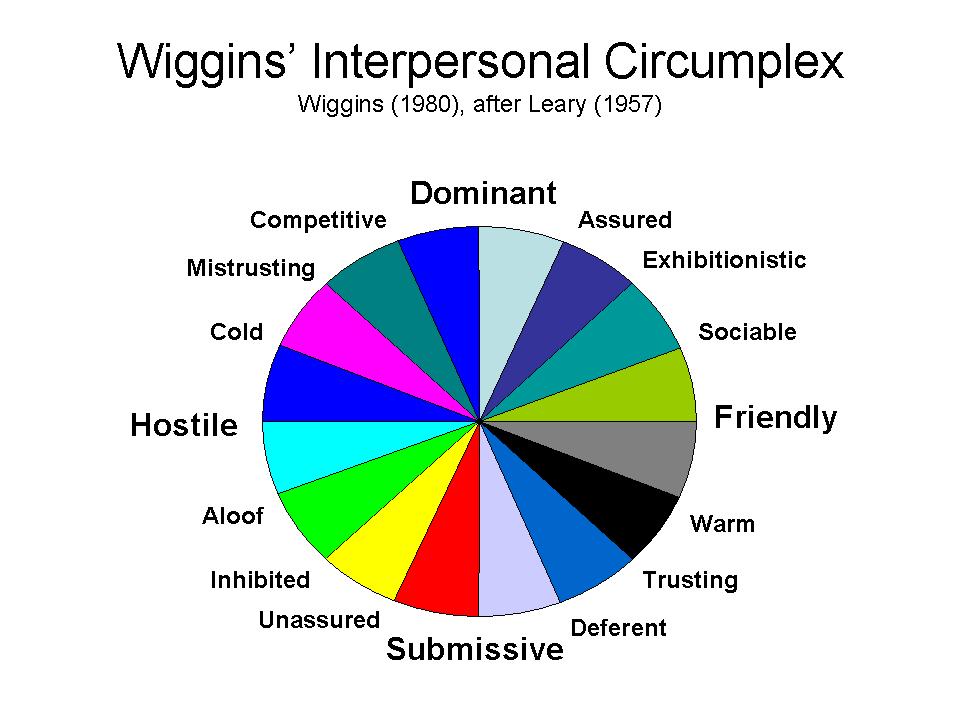 Interestingly,
the relations among these traits, when expressed
geometrically, form a structure known as a circumplex, or a
two-dimensional circular ordering in which the trait relations
are shown in terms of angles between vectors representing the
traits. Some traits, such as ambitious and lazy or extraverted
and introverted, are antonyms and are separated by an angle of
180 degrees representing a perfect negative correlation. Other
traits, such as ambitious and dominant or warm and agreeable,
are so closely related as to be almost redundant, and their
perfect positive correlation is represented by an angle of 0
degrees. Still other traits, such as gregarious and unassuming
or arrogant and aloof, are completely unrelated, as expressed
by an angle of 90 degrees. And finally, other traits, such as
ambitious and gregarious or introverted and submissive, are
positively but not perfectly correlated, as expressed by an
angle of 45 degrees.
Interestingly,
the relations among these traits, when expressed
geometrically, form a structure known as a circumplex, or a
two-dimensional circular ordering in which the trait relations
are shown in terms of angles between vectors representing the
traits. Some traits, such as ambitious and lazy or extraverted
and introverted, are antonyms and are separated by an angle of
180 degrees representing a perfect negative correlation. Other
traits, such as ambitious and dominant or warm and agreeable,
are so closely related as to be almost redundant, and their
perfect positive correlation is represented by an angle of 0
degrees. Still other traits, such as gregarious and unassuming
or arrogant and aloof, are completely unrelated, as expressed
by an angle of 90 degrees. And finally, other traits, such as
ambitious and gregarious or introverted and submissive, are
positively but not perfectly correlated, as expressed by an
angle of 45 degrees.
Wiggins argues that each of these traits can be conceptualized in terms of three facets of interpersonal behavior:
-
directionality (acceptance or rejection);
-
object (self or other); and
-
resource (love or status).
Thus, the relations among traits derived from ratings parallels the conceptual similarities among these adjectives, which is as it should be if our language means anything at all. Nevertheless, as Goldberg (1981) points out, a circumplex is a two-dimensional space, so Wiggins' list of eight traits actually resolves to two, affiliation (love) and power (status) -- or, as Wiggins himself noted (see the Lecture Supplement on "Psychological Development", the stereotypical Western gender-roles of agency and communion. Therefore, Wiggins' circumplex simultaneously incorporates two levels of description: a very economical but somewhat impoverished two- factor structure, and a rather more rich but still highly organized eight- factor one.
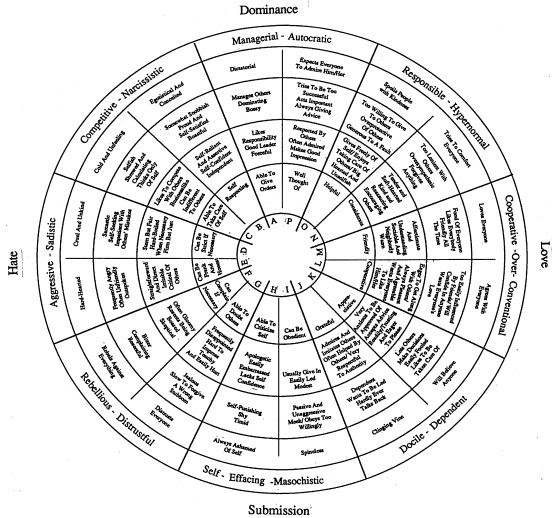 Wiggins'
work was an extension or earlier work by Timothy Leary (1957)
-- yes, the same Timothy Leary who advised people to "Turn On,
Tune In, and Drop Out". Work on the structure of personality
traits continues apace. The chief product of this work is
likely to be a concise vocabulary which permits what
personality psychologists have sought for a long time: the
efficient and accurate description of individual differences
in behavior.
Wiggins'
work was an extension or earlier work by Timothy Leary (1957)
-- yes, the same Timothy Leary who advised people to "Turn On,
Tune In, and Drop Out". Work on the structure of personality
traits continues apace. The chief product of this work is
likely to be a concise vocabulary which permits what
personality psychologists have sought for a long time: the
efficient and accurate description of individual differences
in behavior.
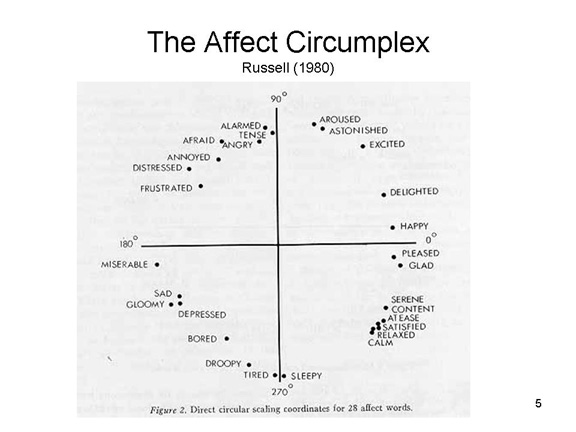
A "Big Two"?
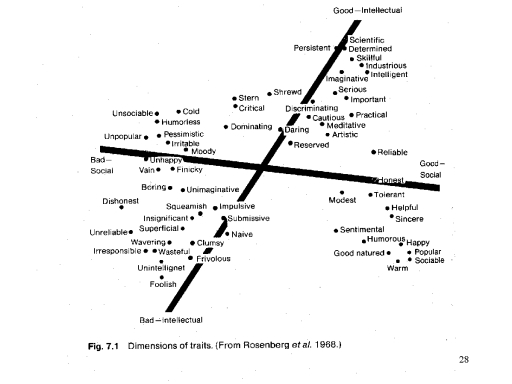 Wiggins
offers us a somewhat expanded set of basic personality traits
-- what you might call a "Big Eight" bipolar dimensions. How
about something smaller? Seymour Rosenberg and his colleagues
(Rosenberg, 1977; Kim & Rosenberg, 1980) has reported that
eventually, factor-analysis of personality ratings yields a
single factor of evaluation, or good-bad. He has also reported
that this factor may be broken up into two subordinate
dimensions of intellectual good-bad and social good-bad.
Wiggins
offers us a somewhat expanded set of basic personality traits
-- what you might call a "Big Eight" bipolar dimensions. How
about something smaller? Seymour Rosenberg and his colleagues
(Rosenberg, 1977; Kim & Rosenberg, 1980) has reported that
eventually, factor-analysis of personality ratings yields a
single factor of evaluation, or good-bad. He has also reported
that this factor may be broken up into two subordinate
dimensions of intellectual good-bad and social good-bad.
Evaluation |
Intellectual |
Culture |
Social |
Surgency |
|
Agreeableness |
||
Conscientiousness |
||
Emotional Stability |
Still, if you were going on a blind date, and asked what your date would be like, you'd want more information than that he or she is "socially desirable", or even that s/he's "friendly and smart". You'd want more, but you wouldn't need too much more. Setting aside issues of personal appearance, when it comes to personality you wouldn't need more than The Big Five -- which is why I sometimes call them
The Big Five Blind Date Questions
Is she friendly?
Is she cooperative"
Is she reliable?
Is she crazy?
Is she interesting?
Really, what more do you need?
The Discovery of Traits
While trait-names are to be found in language, traits themselves are expressed in actions. Accordingly, another group of researchers have looked to people's behavior, rather than to the dictionary or to the global impressions. that they make on others, for clues to the structure of personality. The assumption is that behaviors which cohere together are related through some underlying trait.
Traits as Constructs
The traits discussed by Allport and others working within this tradition of personality psychology are hypothetical constructs employed to explain individual differences in behavior. In an important paper, Cronbach and Meehl (1955), respectively at Stanford University and the University of Minnesota,. defined a construct as "some postulated attribute of people, assumed to be reflected in test performance". The attribute need not be a trait, of course: it may be a temporary state such as sleep or hypnosis; a motive such as avoidance or craving; or a mental representation such as an image or a memory. Traits, states, motives, mental representations, and the like cannot be observed directly, yet we often infer their existence on the basis of what someone says or does. When Fred has an opportunity to cheat on an exam yet does not do so, we may say he possesses a trait of honesty; when Wanda goes to a great deal of trouble to introduce herself to all the guests at a party, we may say she possesses a trait of sociability.
We constantly employ hypothetical constructs when making inferences about the behavior of other people (and ourselves, for that matter). Of course, these inferences are not necessarily valid. Bill may actually fear expulsion from school, and Wanda may just be lonely. What is required is a set of procedures by which we can determine whether our inferences about other people -- whatever they may be -- are valid. Cronbach and Meehl argued that we could validate our inferences by erecting a nomological net around a construct -- that is, by developing a network of laws relating hypothetical constructs to observable behavior. In some cases, a number of hypothetical constructs may be tied together in the form of a theory about individual differences, emotion, cognition, or whatever. In a very large- scale theory, it may not be possible to relate every single construct to observable evidence. Cronbach and Meehl permitted such constructs, so long as the theory included statements specifying how these constructs were related to others which did have empirical referents. In any event, the more hypothetical constructs are related directly to observables, the stronger the nomological net.
Cronbach and Meehl (1955) argued for the necessity of a concept like construct validity in psychological research. Later, other authorities spelled out in more formal terms the criteria by which the validity of a construct may be established.
Three Components of Construct Validity
In another important article, Jane Loevinger (who once taught at the University of California, Berkeley) argued that there were three essential elements to construct validity: substantive, structural, and external validity (Loevinger, 1959).
Substantive validity. An explicit theory must guide the selection of empirical data relevant to the construct. It is not proper for a psychologist to take just any item of behavior and explain it in a post-hoc fashion in terms of his or her favorite construct. Most of the things we do are ambiguous in one way or another, and can be interpreted in many different ways. The investigator's theory of the construct must specify exactly what kinds of observations will provide evidence for the validity of the construct. Loevinger went further in insisting that investigators also include in their research procedures observations that were judged by the theory to be irrelevant to the construct, as a kind of check on the theory. For example, if the investigator's theory about some trait is right, variables X and Y should correlate, but neither of these should correlate with Z. If, in fact, Z correlates with X or Y, then the theory must be revised. Finally, Loevinger asked investigators to include in their tests observations deemed relevant to the construct by competing theories. If Smith's theory is right, A and B should correlate, but not C and D; but if Jones is right, the correlations should be just the reverse. If, as it happens, C and D correlate but not A and B, Smith must revise her theory.
Structural validity. Construct validity is almost never established by some single critical test. Rather, there are typically many different manifestations of some underlying construct. The fact that these different manifestations hang together in some way -- in a matrix of positive correlations, for example --provides evidence for the validity of the underlying construct. Loevinger argued that the investigator's theory of the construct must specify precisely what relationships among observations are to be expected, by means of some measurement model.
Consider the following behaviors, which have been drawn from a personality questionnaire, the Jackson Personality Inventory (Jackson, 1976).
1. My life would be miserable if I didn't know a lot of people.
2. I enjoy group activities more than the things I do by myself.
3. I dislike eating alone.
A. I only telephone friends when there is something important to discuss.
B. It wouldn't bother me to go for days without seeing another person.
C. I like working where I won't be bothered by others.
According to a cumulative model of the trait of extraversion, people who manifest behaviors 1, 2, and 3 are more extraverted than those who manifest only one or two of these behaviors. Similarly, since behaviors A, B, and C are manifestations of introversion, individuals who manifest none of these behaviors are more extraverted than individuals who manifest some or all of them. In the cumulative model, positive and negative evidence for a trait is summed into a single score. In this case, a correlation matrix should show significant relationships between different behaviors relevant to the trait. According to a class model, any one of be behaviors 1, 2, and 3 might be sufficient evidence of extraversion, but a person who manifests two or three of these behaviors is not necessarily more extraverted than one who displays only one of them. With such multiple paths (Hilgard, 1979) to extraversion, we would not expect to see very high intercorrelations among various items all deemed relevant to the trait. According to a dynamic model, an extraverted person could display either behaviors such as 1-3 or behaviors such as A-C. For example, a theory might say that a person who showed Behavior B might still be extraverted -- it's just that he's trying hard not to show it. Where a cumulative model would predict a negative correlation between behaviors 1 and A or 2 and B, then, a dynamic model would not be surprised to find a positive correlations between behaviors that, on the surface, seem contradictory.
Cumulative models are the most popular models employed in trait research. Typically, the investigator assembles a variety of test items relevant to some trait, observes the behavior of a group of people on each of the tests, and then inspects the relationships between the tests by means of procedures which we will describe in detail later. Eventually, s/he settles on a small set of observations which seem to provide reliable positive and negative evidence that a person possesses a certain trait. Scores on these individual test items are combined by addition (for positive observations) and subtraction (for negative behaviors). into a single score. Individuals with high scores are said to possess more of the trait than those with low scores. Dynamic models may strike the reader as odd at this juncture, but there are prominent theories which employ them. Loevinger does not favor any particular model over any of the others. She simply insists that the investigator have some model in mind.
External validity. Within trait psychology, items of a particular type (self-reports, observer ratings, or laboratory behavior) are often combined according to some measurement model into a test of individual differences on some dimension. For example, the Jackson Personality Inventory (Jackson, 1976) contains some 20 items similar to those listed above. For each item, some response (True or False) indicates social participation (an aspect of extraversion) according to his theory, and individual differences may be plotted along a continuum from low to moderate to high. For some investigators (though not for Jackson), this would be sufficient.
Loevinger disagrees. According to her analysis, construct validity requires that one kind of test of a postulated attribute (self-reports, for example) predict scores on some other kind of test specified by the theory. For example, scores on Jackson's Social Participation scale might. be expected to correlate with the Extraversion scale devised by Eysenck and Eysenck (1975). Alternatively, certain groups (such as undergraduate fraternity or sorority members) might be expected to score higher on a test of sociability compared to certain other groups (such as nonmembers). Or, the theory might predict that test scores would change as a result of maturation or certain life experiences, or that high-scorers might respond differently than low-scorers when placed in some particular situation (such as a Friday night beer-and-dancing party). Whatever the criterion is, a construct does not possess external validity unless scores on one test can be shown to relate to scores on another test of the same trait.
The Multitrait-Multimethod Matrix
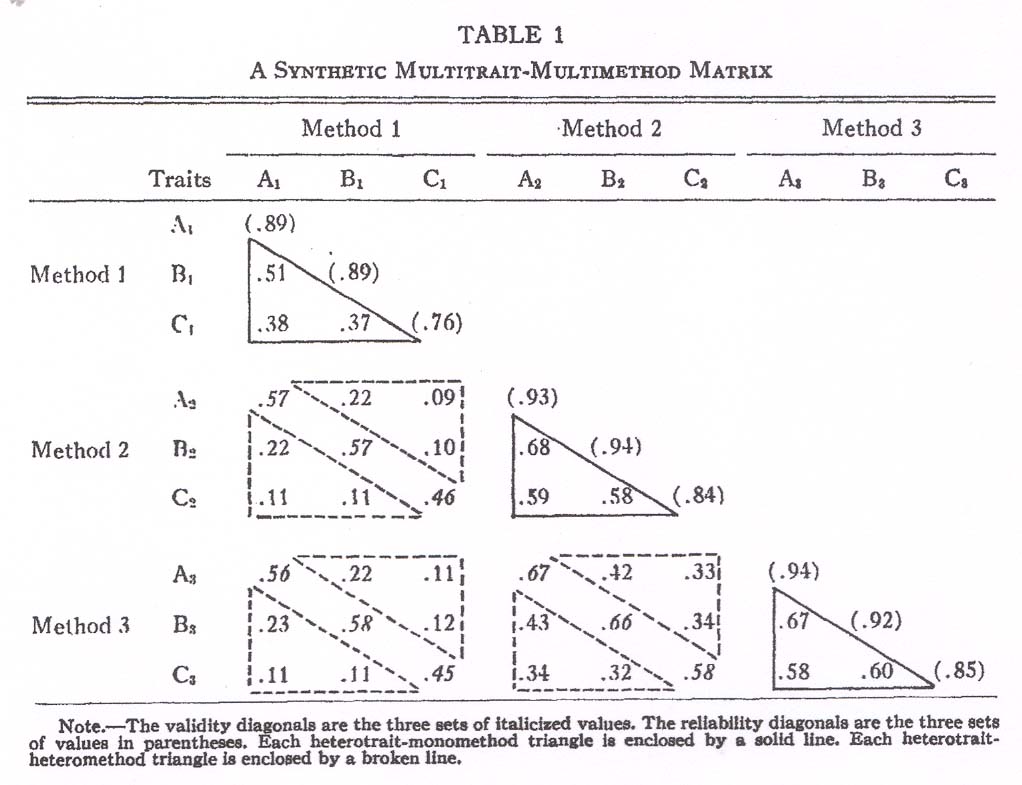 In
another important paper, Campbell and Fiske (1959) elaborated
on the external considerations in construct validity.
Following a more general argument (Garner, Hake, &
Erickson, 1956), they argued that constructs should not be
uniquely identified by any single measurement operation (such
as self-report questionnaires). Rather, they argued that
multiple measurements (such as self-reports, observer ratings,
and laboratory tests) should all converge on a construct. This
sort of convergent validity is represented in the multitrait
multimethod matrix (illustration from Campbell & Fiske,
1959). Assume that a sample of people have been assessed on
three different traits: extraversion, social responsibility,
and achievement orientation. Also, assume that each of these
traits has been measured by three tests: self-reports on a
questionnaire, ratings made be people who have had the
opportunity to observe the subjects in a variety of
situations; and performance in some laboratory experiment
contrived by the investigator. The figure shows the
(hypothetical) correlations between each of the nine
variables, three measures of three traits.
In
another important paper, Campbell and Fiske (1959) elaborated
on the external considerations in construct validity.
Following a more general argument (Garner, Hake, &
Erickson, 1956), they argued that constructs should not be
uniquely identified by any single measurement operation (such
as self-report questionnaires). Rather, they argued that
multiple measurements (such as self-reports, observer ratings,
and laboratory tests) should all converge on a construct. This
sort of convergent validity is represented in the multitrait
multimethod matrix (illustration from Campbell & Fiske,
1959). Assume that a sample of people have been assessed on
three different traits: extraversion, social responsibility,
and achievement orientation. Also, assume that each of these
traits has been measured by three tests: self-reports on a
questionnaire, ratings made be people who have had the
opportunity to observe the subjects in a variety of
situations; and performance in some laboratory experiment
contrived by the investigator. The figure shows the
(hypothetical) correlations between each of the nine
variables, three measures of three traits.
A matrix of this sort can be analyzed in a variety of ways.
-
First, we might look at trait variance -- whether there are significant positive correlations among different measurements of the same trait. If so, then we have evidence of convergent validity.
-
Next, we might look for method variance -- whether there are significant correlations between two tests employing the same method, even though they are measures of different traits. This can happen: as it happens, people have a tendency to answer "yes" to questionnaire items, regardless of their content (a tendency called acquiescence; and raters have a tendency to make favorable judgments about people, regardless of the attribute involved (the halo effect; see ref). If two traits are both measured by a method which is susceptible to this sort of response bias, then there will be a correlation between the tests which is entirely an artifact of the measurement method employed, and have nothing to do with the actual relationships among the traits themselves.
Trait variance is highly desirable, of course, and unfortunately some degree of method variance is probably unavoidable. However, the correlations between tests sharing neither trait nor method variance should be minimal. If this is the case, and trait variance is higher than method variance, then we have evidence for discriminant validity., This discussion assumes, of course, a theory which holds that these three traits are unrelated to each other. If we held a theory which said that they were related somehow, then the same pattern of correlations among traits should be obtained. regardless of the method of measurement employed.
The Structure of Personality: Classical Theories
With factor analysis and related multivariate techniques in hand, a number of investigators have attempted to provide a complete description of the structure of personality. In this section we discuss three major representatives of the multivariate tradition in personality research: J.P. Guilford, Raymond B. Cattell, and Hans J. Eysenck. Each of these researchers has made different choices about the method of factor analysis, and, as we shall see, the use of different methodologies has yielded rather different solutions to the twin problems of trait-names: how many traits are there, and what are the relations among them? All of these researchers agree, however, on a basic scheme for the structure of personality. Personality is hierarchically organized, with particular actions at the lowest level. These actions are subsumed under various habitual action patterns, which themselves are related to primary traits. Finally, the primary traits may be grouped under several higher- order traits. All three investigators have used factor analysis and related multivariate techniques to fill in this basic scheme. However, each of them has made different decisions about the details of the factor- analytic method, resulting in quite different solutions to the twin problems of trait psychology: how many traits are there? And what are the relations between them? Accordingly, they have arrived at quite different structures for personality (Guilford, 1975).
Guilford
J.P. Guilford is one of the major theoreticians of the multivariate movement in personality. He began working with factor analysis in the 1930s, in collaboration. with his spouse, R.B. Guilford, and W.S. Zimmerman. His major contribution to personality theory is his 1959 book, Personality, in which he set forth a complete system for conceptualizing individual differences in terms of five different categories of traits.
Somatic traits. These dimensions represent strictly physical and physiological characteristics, including head size, general bodily length, and muscular thickness. Guilford, unlike Kretchmer and Sheldon, does not believe that there is any important relationship between personality and constitution -- in fact, he refers to the notion as a "will-o'-the-wisp" (1959, p. 335). Nevertheless, he includes these dimensions in his system because he wishes to construct a complete description of individual differences.
Hormetic traits. These are the biological and social motives underlying the individual's aspirations and interests. Guilford and his colleagues (Guilford, Christensen, Bond, & Sutton, 1964) performed a factor analysis of questionnaire data pertaining to "human interests" gathered from a sample of 900 Air Force personnel, which was reduced to 600 by elimination of illiterate and nonwhite respondents. Factor analysis revealed 28 interests, classifiable into nine categories.
-
Organic Needs (temporary biological states such as hunger, thirst, sex, and thermoregulation).
-
Physical Drive, or the tendency to be energetic
-
-
Environmental Needs (desirable environmental conditions)
-
Succorance, the need for a soft environment
-
Meticulousness (orderliness)
-
Need for attention (the drive to be noticed by others)
-
-
Achievement Needs (those related to the desire to succeed or excel in some activity)
-
General Ambition (level of aspiration)
-
-
Self-Determination Needs (the desire to be self-directed)
-
Freedom/Nonconformity
-
Self-Reliance/Dependability
-
Cultural Conformity/Conservatism
-
Emotional Expressiveness/Risk-Taking
-
-
Social Needs (the desire to do things with, for, and to other people).
-
Sociability/Friendliness/altruism
-
Social Initiative/Leadership
-
aggression/Coercive Control
-
-
Avocational Interests (those activities which people like regardless of their vocation)
-
Adventure/Travel
-
Diversion/Recreation/Escape from Routine/Spectator Sports
-
Variety/Change
-
Precision/Concern with Quality
-
Physical Fitness/Sports Participation
-
-
Appreciative Interests (of the arts and literature, for example)
-
General Cultural Interest/Concerned Citizen
-
Aesthetic Appreciation (not appreciation of nature)
-
-
Intellectual Interests (for various types of cognitive activity)
-
Reflectiveness/Rigorous Thinking
-
Autistic Thinking/Fantasy
-
-
Vocational Interests (career goals)
-
Math/Physical Science/Empirical Social Science
-
Aesthetic Expression (creation or performance)
-
Social Welfare/Health/Public Relations (changing people or environments)
-
Business/Economics
-
Clerical
-
Mechanical (design, construction, repair)
-
Outdoor Work (agriculture, construction)
-
Guilford did not claim that this was an exhaustive list of human interests, and recognized that samples of respondents with different. cultural and educational backgrounds might yield a somewhat different set of factors, but these nine categories give the flavor of what he had in mind by hormetic traits.
Temperamental traits. Beginning in the 1930s, Guilford began a series of factor analyses of emotional and behavioral dispositions. In his final analysis (Guilford & Zimmerman, 1956), he administered a carefully refined questionnaire consisting of 70 such items to a sample of 213 people. Factor analysis yielded 14 factors in three categories.
-
General Dispositions (attitudes toward one's environment)
-
General Activity/Impulsivity/Liking for Action
-
Masculininity/Femininity in vocational/avocational interests (stereotypes)
-
Confidence/Poise/Self-Satisfaction
-
Reflectiveness/Curiosity
-
Restraint/Self-Control/Responsibility/Seriousness
-
Objectivity/Realism
-
-
Emotional Dispositions (characteristic styles of emotional response)
-
Depression/Worry/Anxiety
-
Uncontrolled/Immature Emotional Expression
-
Impulsivity/Emotional Instability
-
Relaxation/Composure
-
-
Social Dispositions (characteristic ways of responding in the social environment)
-
Sociability/gregariousness
-
Ascendance/Self-assurance
-
agreeableness/Compliance
-
Cooperativeness/Tolerance
-
Again, Guilford made no claim to producing a complete list of temperamental traits. However, he did publish the Guilford-Zimmerman Temperament Schedule (GZTS), a widely used personality inventory measuring the 10 most reliable temperamental traits.
-
G - General Activity
-
R - Restraint
-
A - Ascendance
-
S - Sociability
-
E - Emotional Stability
-
O - Objectivity
-
F - Friendliness
-
T - Thoughtfulness
-
P - Personal Relations
-
M - Masculinity
Aptitudinal traits. Perhaps Guilford's most original contribution to the study of individual differences is the Structure of Intellect, a theory concerning the nature of intelligence and related cognitive abilities. According to the theory, intelligence may be represented by a cube with the following dimensions:
-
Informational Content
-
Figural/Nonverbal/Spatial/Imagistic
-
Symbolic Codes (number system, musical notation)
-
Verbal/Semantic
-
Behavioral/Social
-
-
Operations which can be performed on these contents
-
Cognition (awareness, recognition, comprehension)
-
Memory (purposeful retention, retrieval)
-
Evaluation/Comparison
-
Convergent Production (problem-solving with a single correct solution)
-
Divergent Production (creativity with many permissible solutions)
-
-
Products resulting from these operations
-
Units differentiating figure from ground
-
Classes, abstract concepts based on common properties
-
Relations, ordering units within classes
-
Systems, constructing or perceiving patterns or structures
-
Transformations, changing information to create new knowledge
-
Implications, developing expectations and predictions
-
The theory holds that there are four kinds of contents, five different operations, and six specific products; thus it predicts 120 different intellective factors resulting from specific combinations of contents, operations, and products (4x5x6=120). Guilford's own research identified tests for 98 of these 120 factors postulated by the theory. However, the testing process also revealed new classes of intellectual abilities not predicted by the original theory, so that more than 20 new cells have been added to the original Structure.
For a further description of Guilford's "Structure of Intellect", see the Lecture Supplement on "Thinking".
Pathological traits. Guilford argues that concepts derived from the study of disturbed individuals cannot be used to understand the structure of normal personality. His goal has been to generalize from the normal to the abnormal rather than the reverse. However, he argues that a separate set of traits may be necessary to fully represent individual differences within the domain of psychopathology. Factor-analytic studies of symptom-ratings made on psychiatric patients have yielded a variety of "neurotic" and "psychotic" factors, including neurasthenia, obsessive-compulsive-phobic behavior, gastrointestinal complaints, paranoia, and depression.
Hierarchical Structure.
Guilford's 1959 system provides a nice illustration of the hierarchical structure of personality.
Setting aside the somatic and pathological traits, Guilford settled on 13 personality traits at the level of primary factors:
-
S - Social Introversion/Extraversion
-
E - Emotional Sensitivity
-
M - Masculinity/Femininity
-
R - Rhathymia (impulsiveness)
-
T - Meditative Thinking
-
D - Depression
-
N - Nervousness
-
G - General Drive
-
I - Inferiority Feelings
-
C - Cycloid Disposition
-
O - Objectivity
-
F - Freindliness/Hostility
-
P - Personal Relations (cooperativeness)
Factor analysis of the primary factors yielded four superordinate secondary factors:
-
SA - Social Activity (G,A, and S)
-
IE- Introversion/Extraversion (R and T)
-
E - Emotional Stability (C,D,N, I, and O)
-
P - Paranoia (O,F, and P)
Interesting, primary factor M did not load on any of these secondary factors, and disappered as a superordinate factor on its own.
Note: If Guilford favored orthogonal factor analyses, how was he able to extract secondary factors from his 13 primary factors? Guilford thought that the basic dimensions of personality were independent of each other in principle, but in practice measurement of these traits is imperfect, such that some trait measurements are correlated with each other. It's these measurements that were subjected to higher-order factor analysis.
Factor analysis of these secondary factors yielded a single tertiary factor:
-
EH - Emotional Health (P and A)
Guilford's system of individual differences seems very comprehensive, but he himself makes no claim that it is complete. On the contrary, he has postulated additional traits that have not yet been confirmed by factor analysis; and he agrees that some traits revealed by his methods have "doubtful status". The line of research initiated by Guilford continues to be pursued by his students and collaborators. Most recently, for example, they have shifted from primary factors to the secondary factors, in order to determine a more concise list of basic traits (Guilford, 1975). Interestingly, the four such factors that they have found closely resemble four of the "Big Five" factors (i.e., all except intelligence) uncovered in Norman's analysis of the trait lexicon.
Cattell
Another early consumer of factor analysis was Raymond B. Cattell, who developed a number of multivariate techniques in addition to factor analysis. Cattell adopted a rather different approach to factor analysis; than did Guilford. While Guilford preferred to employ orthogonal solutions, Cattell argued in favor of oblique factors. There is a sense in which orthogonal solutions are mathematically purer than oblique ones, so Gulford's choice was defensible. However, Cattell asserted that investigators should let nature speak for itself, and not force any a priori structure on personality. If the major traits of personality were uncorrelated in fact, oblique factor analysis would reveal this; if they were not, orthogonal factor analysis would obscure the true state of affairs.
Obviously, then Guilford and Cattell also differed on the matter of higher-order factors in personality. Guilford assumed that the basic traits of personality would be uncorrelated, and when he found evidence to the contrary he attributed this departure from the ideal to defects in method. Cattell, for his part, was very interested in the relationships among the basic traits, as represented by secondary and tertiary factors of personality.
Guilford and Cattell also differed in their reliance on a priori assumptions concerning the content of the structure of personality. Often, Guilford deliberately set out to document certain factors -- especially in the Structure of Intellect, but also in the development of the Guilford- Zimmerman Temperament Survey. Once again, Cattell preferred to let nature speak for itself, and not impose any preconceived structure on personality. He went to great lengths to prevent his factor analyses from being tainted by specific theoretical commitments -- going so far as to coin new words for many of his traits, so that they would be free from the connotations of familiar descriptive terms.
While Guilford relied almost totally on retrospective self-reports of behavior collected by means of questionnaires, Cattell has employed a large variety of data bases in his analyses:
-
L-data (ratings made by other people who have had the opportunity to observe the subject in everyday life situations;
-
Q-data (self-ratings on questionnaires); and
-
T-data (performance in test situations t carried out under controlled laboratory conditions).
Similarly, while Guilford relied mainly on conventional factor-analytic techniques, Cattell expanded the scope of the method to include a variety of techniques of multivariate analysis (he also coined the term):
-
R-technique, in which many items are completed by many subjects, with the intent of seeing which items go together -- in other words, conventional factor analysis;
-
Q-technique, in which many items are completed by many subjects, but the focus of the analysis is changed so that people are grouped together in clusters based on similar patterns of response; and
-
P-technique, in which a single subject completes a set of many items on several different occasions, in order to assess the consistency and variation in his or her behavior across time.
Finally, while Guilford's analyses were mainly limited to whites (and often white military personnel at that) for reasons of economy and statistical reliability, Cattell has been very interested in cross-cultural studies of the structure of personality, as seen in his comparisons among Americans, Japanese, and other groups (Cattell, 1966).
A final difference is that while Guilford has been primarily concerned with developing a multidimensional matrix for the classification of personality traits, Cattell has been willing to go beyond descriptive nomenclature to address other problems of personality theory. For example, he has attempted to inquire into the biological and environmental sources of various personality traits, and has been concerned with the relations between the structure of personality); and the individual's behavior in specific situations.
Like Guilford, Cattell has employed factor analysis to reveal the structural relations among traits within a number of broad categories. Within each of these domains, he makes a distinction between surface traits (overt behaviors) and source traits (underlying dispositions). Furthermore, source traits are divided into constitutional-mold and environmental-mold traits, depending on their origins in biology or experience. The entire system has evolved over a long period of time, and is described in a series of books (Cattell, 1946, 1950, 1957, 1965).
Abilities. Cattell acknowledges the importance of intellect in personality, but he has not been particularly concerned with studying the factorial structure of ability traits. Rather, following his teacher Carl Spearman (1927), he classified intelligence into two types. Fluid intelligence, in his view, is one's native intellectual ability -- the ability to perceive relationships, sort objects into category, and perform tasks involving analogical and inductive reasoning. In theory, fluid intelligence is determined by one's cortical endowment, a gift of his or her genes. Crystallized intelligence, on the other hand, has to do with the person's specific abilities, acquired through learning --vocabulary, logical thinking, computation, mechanical skills, and the like. While the degree of learning is constrained by the individual's native potential (fluid intelligence), these sorts of specific abilities are determined by his or her cultural experience. Cattell's distinction between fluid and crystallized intelligence has led him to be very interested in cross- cultural studies of intellectual abilities, and he has taken the lead in developing "culture-fair" tests of intelligence that are comparable across people from many cultures -- white and nonwhite, western and nonwestern, educated or illiterate, rural or urban. For more on Cattell's distinction between fluid and crystallized intelligence, see the Lecture Supplement on "Thinking".
Temperaments. The heart of Cattell's system of personality consists of his list of temperamental traits, by which he means emotional and behavioral dispositions. Through factor-analyses of both L-data and Q- data, Cattell has uncovered a set of 15 temperamental traits . Note that many of these traits are given unusual names. This practice stems from his desire not to impose anything on the structure of nature. In his opinion, the concepts of ordinary language are inexact for his taxonomic purposes, and carry too much connotative meaning; thus he has invented neologisms for many of his factors.
Cattell's analyses focused on 12 factors derived from L- and Q-data, supplemented by four factors represented in Q-data alone:
-
A - Cyclothymia
-
Ac - Acquiescence
-
C - Ego-Strength
-
E - Dominance
-
F - Surgency
-
G - Superego-Strength
-
H - Parmia (impulsivity)
-
I - Premsia (gregariousness)
-
L - Protension (paranoia)
-
M - Autia (unconventionality)
-
N - Sophistication
-
O - Guilt-Proneness
-
Q1 - Liberalism
-
Q2 - Self-Sufficiency
-
Q3 - Self-Sentiment Control
-
Q4 - Ergic Tension
In addition, Cattell factor analysis of Q-data found four additional factors unique to Q, and 18 factors unique to T-data.
These traits are assessed in Cattell's Sixteen Personality Factor Questionnaire (16 PF), a popular personality-trait inventory (where, at least, he gave his traits labels in ordinary language).
|
|
Remember that, unlike Guilford, Cattell relied on oblique rotations, meaning that his primary factors could be further factor-analyzed to yield superordinate, secondary factors. When you do this, you get what he referred to as the "Global Scales" of the 16PF:
- Extraversion
- Anxiety Neuroticism
- Corteria-Pathemia (emotional maturity, or tough-mindedness -- a favorite term of Cattell's)
- Independence
- Promethian Will vs. Resignation (essentially, self-control)
Which, just in case you haven't noticed, look a lot like The Big Five -- a point to which we'll return later.
Dynamic traits. Another important feature of Cattell's approach to personality is his emphasis on motivation. Cattell's factor-analytic studies of human motives have focused on two major types of motivational traits:
-
ergs, which as constitutional-mold traits are deeply rooted in our biological endowment; and
-
sentiments, which are acquired, environmental- mold traits.
Ergs and sentiments are considered to be source traits, which find surface expression in attitudes. There is an almost infinite list of possible specific attitudes, covering a wide range of preferences and aversions. The dynamic source traits are linked to particular behaviors through the specific attitudes, in what Cattell terms the dynamic lattice. In his view, behavior is determined largely by specific attitudes, which are expressive of broader social goals, which are themselves necessarily derived from biological goals. The implication of this is that any particular behavior may be driven by any one of a number of different underlying motives. This concept is called overdeterminism, and we shall meet again later, when we discuss the work of Sigmund Freud.
Transient structures. Most of Cattell's work has been concerned with traits, or dispositional tendencies which remain fairly stable over time; and with differences between individuals on dimensions representing intellectual, temperamental, and dynamic traits, as revealed by R-technique and Q-technique, in which many individuals are subjected to a single personality assessment. However, Cattell has also acknowledged the importance of variance within as well as between individuals -- the fact of inconsistency as well as consistency. To account for the instabilities and inconsistencies inevitably observed in individual lives, Cattell has offered the twin constructs of state and role. States are the temporary moods which can affect behavior. Roles refer to temporary dispositions conferred on the individual by social circumstances or by his or her status within some group. As was the case with attitudes, there are too many roles to define in an exhaustive list. In general, however, Cattell distinguishes among them along three dimensions: formal vs. informal, conscious vs. unconscious, and stereotyped vs. genuine. States and roles serve to moderate the behavioral consequences of the intellectual, temperamental, and dynamic source traits.
The specification equation. How does all this fit together? The core of Cattell's approach to personality is in the assertion that one's behavior in any specific situation is predictable from knowledge of his or her abilities, temperaments, motives, states, and roles. This assertion has been formalized in terms of the Specification Equation, whose simplest form is:
B = Sum(bA) + Sum(bT) + Sum(bD) + Sum(bS) + Sum(bR), |
|
| where |
B = Behavior; A = Ability traits; T = Temperamental traits; D = Dynamic traits; S = States; and R = Roles. |
The contribution of each of the traits, states, and roles depending on the behavior which is to be predicted, as indicated by the weights (b) preceding each of the elements. Cattell and his colleagues have actually worked out some preliminary. specification equations for various behaviors, based on the traits measured by the 16PF. For example,
Public Speech = .6(Intelligence) + .5(Surgency) - .8(Timidity),
Thus, the more intelligent one is, and the more sociable and talkative, the more likely one will give a convincing speech. Of these two factors, intelligence is the more important. Timidity counteracts these tendencies, however.
Once again, it should be noted that Cattell's system is not yet complete. Some factors in addition to those presented here have been uncovered by Cattell's factor analyses, but are still considered to be of "doubtful status". In addition, there are important and as-yet-unresolved discrepancies between the factors revealed by analyses of L-, Q-, and T- data. A great deal of work remains to be done to resolve these problems, as well as to reconcile the method-induced discrepancies between Cattell's and Guilford's lists of primary traits (Cattell & Gibbons, 1968). Perhaps the key to all of these problems lies in the superordinate rather than primary factors. Cattell (1973) has reported four third-order factors which closely resemble Guilford's (1975) four second-order factors, as well as four of the "Big Five" of Norman (1963).
Eysenck
A third major factor-analytic approach to personality has been advocated by Hans Eysenck, one of England's leading (and most controversial) psychologists. Eysenck has been particularly critical of those who -- like Guilford and Cattell -- emphasize primary as opposed to superordinate traits. From a theoretical point of view, Eysenck reminds his audience that the purpose of factor analysis is to simplify things, and argues that structures like Guilford's and Cattell's are too complicated to handle efficiently. From an empirical point of view, Eysenck asserts that Guilford's and Cattell's primary traits have proved difficult to confirm in other samples. For example, Soueif, Eysenck, and White (1969). administered the GZTS and 16PF -- the questionnaires which allegedly contain the best-documented traits in both systems --to a large sample of subjects. When the questionnaire items were successively factor-analyzed according to Guilford's and Cattell's preferred methods, the 10-scale GZTS yielded 12 factors with considerable correspondence between Guilford's and Eysenck's interpretations; but the 16PF yielded 10 factors whose interpretation corresponded poorly with that proposed by Cattell (for replies see Cattell, 1972; Guilford, 1975). For these and other reasons, Eysenck has limited his solution to only a few factors -- originally two, now expanded to four. By focusing on higher-order, orthogonal factors he hopes to achieve an optimally simple and stable (replicable) solution to the dimensional structure of personality.
Some other features of Eysenck's approach to personality bear mention at this point. Like Cattell, he employs data from laboratory tests as well as self-report questionnaires. However, he approach is explicitly theory- driven: he has an a priori conception, derived from the work of Wundt and Kretchmer, concerning what the major factors of personality are. His explorations of normal personality are closely tied to clinical concerns, assuming that psychiatric patients have extreme scores on dimensions of personality possessed by normals. Often, psychiatric status (e.g., as a schizophrenic, a neurotic, or a psychopath) provides a criterion variable which aids the interpretation of factors derived from laboratory and self- report data. Eysenck's approach to personality is also closely tied to experimental psychology, depending as it does on concepts associated with learning and biological psychology. Finally, Eysenck is particularly interested in cross-cultural studies of personality. In his view, the major dimensions of personality are biological in nature, and thus should be universal -- independent of cultural differences.
Eysenck's system for personality revolves around four broad traits: intelligence, introversion-extraversion, neuroticism, and psychoticism. Eysenck's conception of intelligence is similar to Spearman's (1927) concept of g, or general cognitive ability, and will not be dealt with further here. His own work has emphasized those three dimensions which are closer to Guilford's and Cattell's temperamental dimensions. His descriptions of these dimensions have much the flavor of the character portrayals of Theophrastus, Kant and others working in the typological tradition -- and, in fact, Eysenck often refers to these traits as types. However, the term means something quite different for Eysenck than it does for the others: it refers not to categories of people, but to superordinate dimensions of individual differences which are themselves collections of many primary traits. The following descriptions are taken from Eysenck (1969).
Extraversion-Introversion. The typical extravert is sociable, likes parties, has many friends, needs to have people to talk to, and does not like reading or studying by himself. He craves excitement, takes chances, often sticks his neck out, acts on the spur of the moment and is generally an impulsive individual. He is fond of practical jokes, always has a ready answer, and generally likes change. He is carefree, easygoing, optimistic, and likes to "laugh and be merry". He prefers to keep moving and doing things, tends to be aggressive and to lose his temper quickly. His feelings are not kept under tight control and he is not always a reliable person.
The typical introvert is a quiet, retiring sort of person, introspective, fond of books rather than people; he is reserved and distant except to intimate friends. He tends to plan ahead, "looks before he leaps", and distrusts the impulse of the moment. He does not like excitement, takes matters of everyday life with proper seriousness, and likes a well-ordered mode of life. He keeps his feelings under close control, seldom behaves in an aggressive manner, and does not lose his temper easily. He is reliable, somewhat pessimistic, and places great value on ethical standards.
Neuroticism. Neurotic individuals tend to be emotionally overresponsive and to have difficulties in returning to a normal state after emotional experiences. Such individuals frequently complain of vague somatic upsets of a minor kind, such as headaches, digestive troubles, insomnia, backaches, etc., and also report many worries, anxieties, and other disagreeable emotional feelings. Such individuals are predisposed to develop neurotic disorders under stress but such predispositions should not be confused with actual neurotic breakdown; a person may have high scores on N while yet functioning adequately in work, sex, family, and society spheres.
Psychoticism. These individuals generally have complaints about poor health, bad luck, and in general "problems in living". They worry about catching diseases. They tend to have had poor relationships with their parents, both male and female. They may be rather cruel -- they enjoy hurting people who are close to them, and don't get very upset when they see other people or animals suffer. They have poor peer relationships, are suspicious, and take offense very easily. They complain of unusual perceptual experiences.
As with Guilford and Cattell, evidence for these traits emerges from factor analysis. Interestingly, factor-analyses of all major personality questionnaires and other ratings eventually yield two major higher-order dimensions which correspond to Eysenck's concepts of introversion- extraversion and neuroticism (Eysenck, 1969; Royce, 1973s). The evidence for psychoticism as a normal personality trait is as yet ambiguous. Some hints of its existence came from factor-analyses of personality. ratings of psychiatric patients (Eysenck, 1960; Trouton & Maxwell, 1956), which revealed two relatively unrelated factors. Because Eysenck postulates an essential continuity between normal and abnormal populations (the abnormal simply being more extreme), he has added psychoticism to his list of dimensions of normal personality. (Eysenck & Eysenck, 1976). Eysenck has identified a series of laboratory tasks involving perception, memory, and learning which also reflect these factors, and his method of criterion analysis has shown that groups of psychiatric patients differ in expected ways on these three dimensions of personality. The three traits are typically measured by self-report questionnaires, such as the Eysenck Personality Questionnaire; early version of this scale the Maudsley Personality Inventory, was limited to introversion-extraversion and neuroticism.
Personality and arousal. Perhaps more than any other factor-analytic theorist of personality, Eysenck's work is tied to an explicit theory concerning the origins of the major dimensions of personality and how they affect ongoing cognition and behavior. At a descriptive level, Eysenck's factors are similar to those dimensions which Wundt (1903) extracted from Kant's (1798) fourfold scheme of personality types. Generally, Introversion-Extraversion corresponds to speed of emotional arousal, while Neuroticism corresponds to strength of emotional arousal. Theoretically, individual differences on these dimensions are related to brain functions associated with arousal. This part of the theory has seen a great deal of development, with two major versions announced some 10 years apart (Eysenck, 1957, 1967). For purposes of simplicity, we will confine our discussion to the 1967 version of the theory.
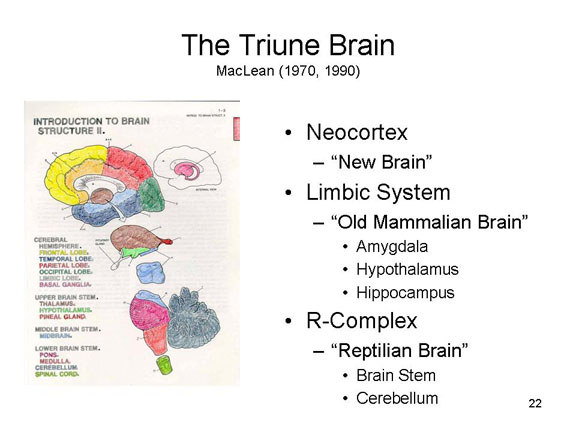
According to Eysenck, cortical arousal affects the easy and efficiency of learning and problem-solving in nonemotional situations, while autonomic arousal controls emotional response and behaviors related to primitive biological motives such as hunger, thirst, fear, and sex. From this point of view, cortical and emotional arousal can be elicited by appropriate stimuli. In addition, Eysenck holds that the individual's genetic heritage endows him or her with characteristic levels of arousal in these two domains (and, for that matter, intelligence and psychoticism as well). Thus, for Eysenck, in the final analysis personality is determined by genetic factors, just as surely as eye color or skin pigmentation. For the most part, the cortical and autonomic arousal systems work independently, so that arousal in one does not necessarily entail arousal in the other. The only exception to this rule is with high levels of autonomic arousal or neuroticism, where there is emotional arousal to stimuli which under ordinary circumstances would lead only to cortical arousal.
How does all this relate to behavior? The answer to the question lies in the Yerkes-Dodson Law (Yerkes & Dodson, 1908), a classic formulation of the relation between arousal and task performance. According to the Law, optimum performance on any task is achieved at some moderate level of arousal: if arousal is too low, drowsiness and sleep will impair performance; if it is too high, performance will be disorganized. The relation between arousal and task performance may be represented. by an "inverted U", as discussed in the Lecture Supplement on "Emotion". As tasks become more difficult, the level of arousal which results in optimal performance moves lower on the continuum.
According to the theory, introverts -- those with high levels of cortical arousal -- should show rapid learning in nonemotional domains, especially socialization. Extraverts, by contrast, should be relatively slow at learning to inhibit their impulses and other action tendencies. In this manner, Eysenck and his followers classify alcoholics and psychopaths as "extraverts" because they share a general failure of inhibition (see Gorenstein & Newman, 1980). Neurotics, with their high levels of autonomic responding, should learn especially fast in the emotional domain, acquiring fears and associated coping responses relatively easily and efficiently. When individuals who are high in neuroticism develop psychopathology, their symptoms are those of classic phobics, obsessives, and compulsives.
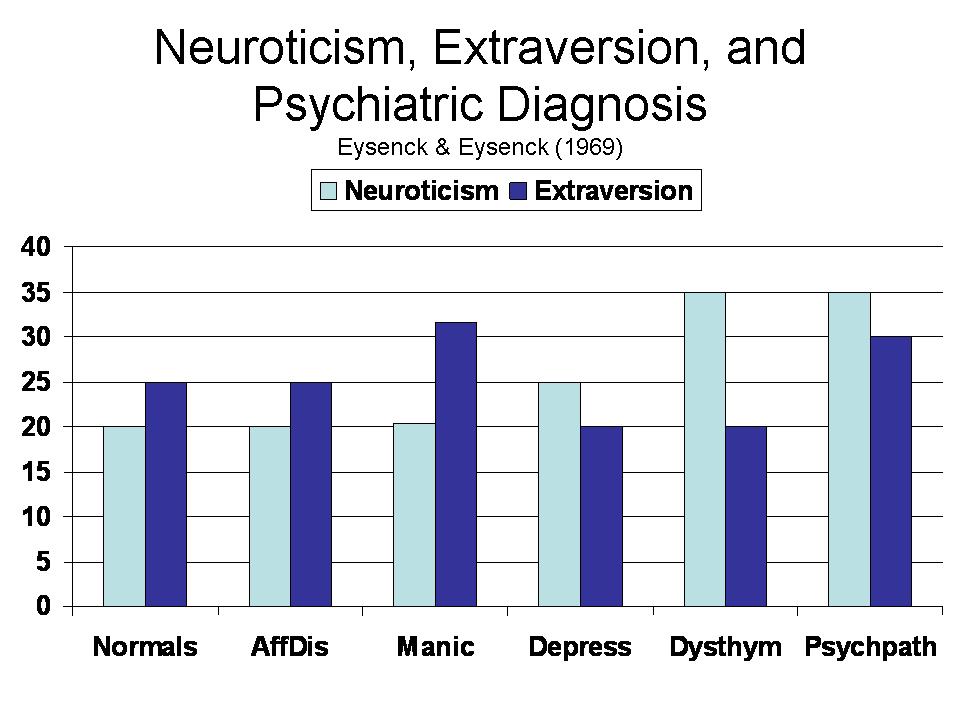 The
figure shows the relative positions of normals and various
groups of psychiatric patients in a two-dimensional space
defined by Extraversion-Introversion and Stability-Neuroticism
(Eysenck, 1969, Table 9.1).
The
figure shows the relative positions of normals and various
groups of psychiatric patients in a two-dimensional space
defined by Extraversion-Introversion and Stability-Neuroticism
(Eysenck, 1969, Table 9.1).
-
Psychotic patients with (bipolar) affective disorder or mania score in the normal range on neuroticism -- which makes sense since, after all, they're psychotic not neurotic.
-
Unipolar patients with depression score higher on neuroticism, while those with mania score higher on extraversion.
-
Dysthymic patients, who suffer from a chronic, low-grade depression, score very high on neuroticism.
-
Psychopaths score very high on extraversion.
In addition to relating his dimensions to psychiatric disorder,. Eysenck and his associates have also sought direct evidence about arousal levels by examining the performance of normals differing on these traits in various experimental situations. involving learning, perception, memory, physiological response, and the like (for reviews see Eysenck, 1967, 1981; Wilson, 1978).
-
For example, a number of studies indicate that introverts have lower sensory thresholds than extraverts, meaning that they perceive stimuli at lower intensities, and perform better on vigilance tasks, in which they have to detect signals briefly and irregularly presented to them. Both these findings are consistent with the hypothesis of higher cortical arousal.
-
Similarly, introverts condition more rapidly than extraverts when the unconditioned stimulus is relatively weak. However, when the US is strong, extraverts condition more rapidly. Eysenck relates this to differences in preferred level of stimulation. Introverts, being already highly aroused, perform best with minimally arousing stimuli, because then their total arousal does not shift them further off the peak of the Yerkes-Dodson curve.
-
Extraverts, being underaroused, require the additional arousal from strong stimulation to reach that peak in the first place.
-
-
Other experiments have examined the effects of psychoactive drugs. For example, introverts are more difficult to sedate with barbiturates than extraverts: they have farther to move on the continuum of arousal, apparently. Sedatives administered mild doses enhance the performance of introverts, presumably by bringing them closer to the peak of the Yerkes- Dodson curve; stimulants in mild doses enhance the performance of extraverts, presumably for the same reason; sedatives impair the performance of extraverts, while stimulants impair the performance of introverts.
-
Similar patterns of performance have been related to individual differences in stability-neuroticism. However, it should be noted that these findings have not always been. consistently replicated, and that in the cases of positive findings the group differences are typically undramatic.
-
-
Moreover, direct physiological measures of arousal have not supported the basic hypothesis that introversion is related to high cortical arousal (as measured by EEG), and neuroticism is related to high autonomic arousal (as measured, for example, by EKG). It will be some time before the mass of data generated by Eysenck and his associates can be synthesized, and a pattern abstracted from it. The extraversion- introversion and stability-neuroticism dimensions are there -- the personality rating data tells us so. While the arousal theory is plausible, it is by no means confirmed.
Psychoticism: A Dimension of Normal Personality? While there has long been evidence of a factor of psychoticism fairly independent of neuroticism in the population of psychiatric patients, only recently has Eysenck offered evidence for this trait as a separate dimension of normal personality as well (Eysenck & Eysenck, 1975). However, from the beginning there have been doubts raised about the status claimed for this trait (e.g., Davis, 1974; Forbes, 1976). For example, Bishop (1977) showed that scores on an early version of the psychoticism scale did not discriminate between hospitalized psychotics and (presumably nonpsychotic) art students. Moreover, some nonpsychotic groups such as prisoners, alcoholics, and drug addicts scored higher than psychotics on the scale. Debate then proceeded in an remarkable exchange between the Eysencks. and their supporters (Eysenck, 1977; Eysenck & Eysenck, 1977; Claridge & Birchall, 1978) and Block (1977a, 1977b, 1978), who also expressed qualms about the trait.
Eysenck (1977) offered new evidence previously unavailable to Bishop, some of it based on a revised psychoticism scale. With respect to the most damaging point -- the near-total overlap between psychotic and non- psychotic groups on the psychoticism scale -- Eysenck showed that the scale did, in fact, significantly discriminate between the two groups. Further, he argued on theoretical grounds that criminals, substance abusers, and psychotics shared an underlying psychological and biological predisposition to maladjustment. Finally, he argued that psychotics are less likely to reply truthfully on self-report questionnaires; and that if they did they would, in fact, show elevated psychoticism scores that would finally distinguish them from other nonnormals. In reply, Block (1977a) demonstrated empirically that lying on the scale did not account for individual differences in scores within the psychotic group. While agreeing that the differentiation between psychotics and normals was statistically significant, he complained that the resolving power of the scale was so poor that large numbers of normals would be. inappropriately and unfairly categorized as psychotic by the scale. Finally, Block pointed out that the scale contains many items concerned with antisocial behavior, in addition to items dealing with such classic features of psychosis as thought disorder and suspiciousness. Thus, far from sharing the same underlying biological and psychological predispositions, criminals and psychotics might achieve equivalent scores on the scale for quite different reasons. In any event, so much ambiguity surrounds the psychoticism scale that it seems premature to accept the trait as a dimension of normal personality.
The Bottom Line on Eysenck. Of all the trait theorists, Eysenck has progressed the furthest from mere description towards specific theoretical commitments concerning the origins of personality traits, and the mechanisms by which they affect behavior; and he has done more than any other trait theorist to test these hypotheses in laboratory research, and to relate normal personality to psychopathology. Many of his experiments have been ingenious, involving complex and often counterintuitive predictions. Of course, some predictions fail, and the failure to confirm certain hypotheses has led to revisions in the theory. Recently, important revisions in the theory have been offered by Eysenck's son Michael (1977,1981), Claridge (1967, 1981), and by Gray (1977, 1981). Whether Eysenck's preferred level of describing personality is the optimum one, and whether his theory of extraversion- introversion and neuroticism is correct, is in some respects less important than his having made the attempt to erect a theory of personality on foundations provided. by research and theory in basic psychological processes.
The Big Two. To say this is not, however, to call into question the validity of the two other dimensions, Extraversion-Introversion and Stability-Neuroticism. These factors are ubiquitous in personality-rating data, whether collected by self- or other-ratings, in the form of adjective lists or questionnaires concerning attitudes and behaviors.
I'm not a big fan of trait theories of personality, but Eysenck's theory is important. First, he achieved the economy of representation that is the goal of the factor-analytic approach. He produced a simple, elegant theory of both the origin of individual differences (in biology) and their impact on social behavior. This is what a multidimensional trait theory should look like. Unfortunately, the findings of his experimental studies are not simple and elegant, so that he and his associates (who include his extended family -- a psychological dynasty like Cattell's -- have had to engage in a lot of hedging and backtracking. Still, you've got to admire both the ambition and the effort.
Back to "The Big Five"
Interestingly, the "Big Two" types of Eysenck also appear in the "Big Five" traits of Norman (1963), in Guilford's (1975) secondary factors, and in Cattell's (1973) tertiary factors. Eysenck's psychoticism factor, should it eventually be confirmed, would seem (by virtue of its heavy emphasis on antisocial behavior), to be related to Cattell's antisocial unconcern factor, making the links even stronger. Neither Guilford, not Cattell, nor Eysenck have a factor similar to Norman's "culture" dimension. But another label for culture is intelligence (something like IQ), or intellectance (i.e.,appearing to be intelligent), filling out the Big Five structure even more.
Norman |
Guilford |
Cattell |
Eysenck |
Surgency |
Social Activity |
Exvia-Invia |
Extraversion |
Agreeableness |
Paranoid Disposition |
Corteria-Pathemia |
|
Conscientiousness |
Introversion |
Moral Background |
Psychoticism |
Emotional Stability |
Emotional stability |
Anxiety-Adjustment |
Neuroticism |
Culture |
Plainly, the aptitude factors of Guilford and Cattell, Norman's culturedness, and Eysenck's intelligence belong under "intellectual good-bad", as representing different types of intelligence. Similarly, perhaps, the remaining factors may be arranged under "social good-bad", depending on whether the traits are considered socially desirable or not. Thus there may be subordinate categories of socially desirable behavior having to do with extraversion and neuroticism (emotional stability), agreeableness, and conscientiousness. At still lower levels would be the primary factors of Guilford and Cattell. Within this kind of hierarchy, Eysenck argues that research should stay near the top. With two factors, or perhaps three or four, Eysenck seems to have fulfilled the principal goal of the factor- analysts, which is to simplify. While it remains to be determined whether his system obscures some important features of personality and eliminates much of its richness, the choice among the various levels of descriptiveness at present is largely dictated by considerations of personal taste, convenience, and the purpose of the investigation.
From Traits to Types?
The fundamental problem in the psychology of personality is to take account of individual differences, and to determine how they can be conceptualized and described. To this end scientific personologists and nonprofessionals alike employ both type and trait terms. We can say that someone is egocentric, active, sociable, and carefree; of we can say that she is an extravert. Certainly it is easier to do the latter than the former, which may be one reason that stereotypes and other labels abound in the everyday conversation of ordinary people. But there may be a psychologically more interesting reason as well. Type-names are category labels, and a personality description represents the outcome of a perceptual process by which the observer has formed an impression of the subject. As Bruner (REF) has noted, "every act of perception is an act of categorization". Since Adam and Eve named the animals in the book of Genesis, the tendency to label the objects we encounter, including other people, seems to be an irresistible aspect of intelligent cognitive activity.
Although Wundt convinced several generations of psychologists that trait dimensions were superior to type categories for classificatory purposes, typological concepts have been extremely attractive to scientists as well as nonscientists. This is especially true in the field of psychopathology, where patients and clients continue to be described in terms of category labels such as "schizophrenic" and "neurotic" (American Psychiatric Association, 1980; Cantor, Smith, French, & Mezzich, 1980; Spitzer, Endicott, & Robins, 1975; Woodruff, Goodwin, & Guze, REF). Even among nonpatients, Eysenck has often referred to his four superordinate dimensions as "types", even though scores on his personality scales are continuous and normally distributed. And, as we note in the chapter on "Trait Research", investigators interested in relating personality traits to behavior in specific situations will often divide their distributions into halves or quarters to form comparison groups of high- and low-scoring subjects -- thus ignoring potentially important individual differences within these groups.
While these tendencies often result merely from a desire for mental and fiscal economy in the research, other investigators have turned to multidimensional personality inventories such as the GZTS, 16PF, and EPI to establish personality typologies on an empirical rather than an intuitive basis. For example, Eysenck commonly classifies his subjects as neurotic extraverts (scoring high on both neuroticism and extraversion), stable introverts (scoring low on both dimensions), and the like. The same strategy can be applied with more differentiated inventories as well. For example, on Cattell's 16PF, we might find a group of persons who share high scores on intelligence, ego strength, harria, and conservatism, and another group who share low scores on these scales. We might think of these as different personality types, and compare the groups on some measure of interest such as childrearing history or response to stress and frustration. The difficulty with this type of project becomes apparent when we consider that there are 2**16 = 65,536 different possible combinations of high and low scores on the 16PF and a proper empirical classification requires that the investigator look for examples of each of them.
With the advent of high-speed
computers, this formerly impossible (or at least daunting)
task is now relatively cheap and easy to do. All one needs is
a large representative sample of the population to take the
scales, and a computer. The principles by which patterns of
high and low scores may be classified into profiles are now
well understood (Cronbach & Gleser, 1953; Wiggins, 1973).
They have been employed to reveal different categories of
psychiatric patients (Marks, Seamon, & Haller, 1974), and
of hypnotizable subjects (Brenneman, Kihlstrom, & Hilgard,
1982); they have also defined different patterns of
intelligence (Matarazzo, 1972), and personality development
(Block, 1971).
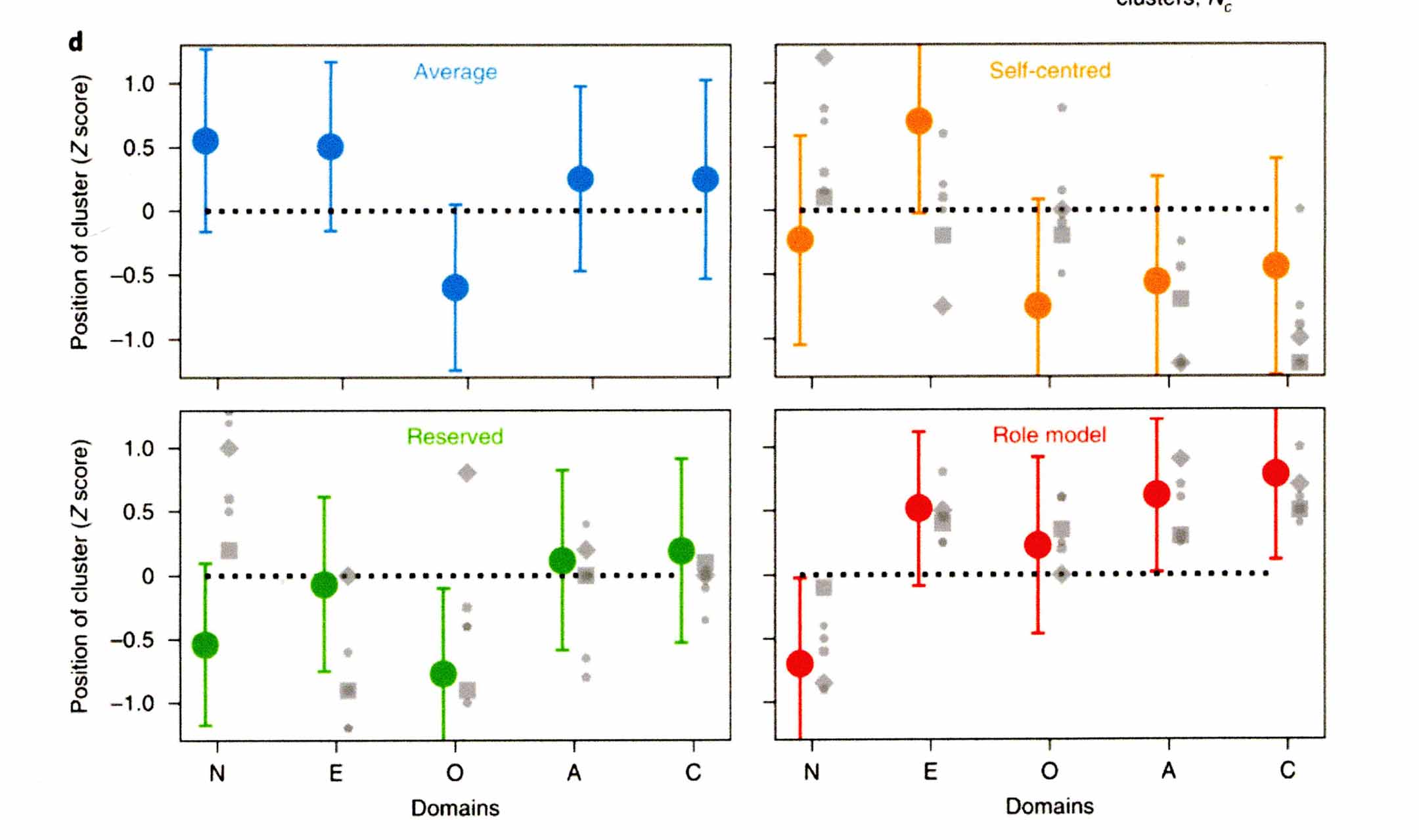 Just
such an exercise has been reported by Gerlach et al. (Nature
Human Behavior, 2018), based on the Big Five personality
traits. Using data from four large samples totaling
about 1.5 million individuals, they performed a
cluster analysis -- a variant on factor analysis which can
identify groups of individuals who share a particular
profile. Of course, with 1.5 million subjects, they
observed just about every possible combination of the Big Five
traits you can imagine. But four profiles appeared much
more frequently that would be expected by chance alone -- so
frequently that it seems reasonable to identify them as
meaningful personality types.
Just
such an exercise has been reported by Gerlach et al. (Nature
Human Behavior, 2018), based on the Big Five personality
traits. Using data from four large samples totaling
about 1.5 million individuals, they performed a
cluster analysis -- a variant on factor analysis which can
identify groups of individuals who share a particular
profile. Of course, with 1.5 million subjects, they
observed just about every possible combination of the Big Five
traits you can imagine. But four profiles appeared much
more frequently that would be expected by chance alone -- so
frequently that it seems reasonable to identify them as
meaningful personality types.
- The "Average" type shows moderately high scores on Neuroticism and Extraversion, moderately low scores on Openness, and about average on Agreeableness and Conscientiousness.
- The "Self-Centered" type shows high scores on Extraversion, average scores on Neuroticism, and relatively low scores on Openness, Agreeableness, and Conscientiousness.
- The "Reserved" type shows low scores on Neuroticism and Openness, and average scores on Extraversion, Agreeableness, and Conscientiousness.
- The "Role Model" type shows low scores on Neuroticism, average scores on Openness, and moderately high scores on Extraversion, Agreeableness, and Conscientiousness.
As Block (1961; Block & Ozer, 1982) has noted, types may be mere linguistic labels, or they may represent "distinctive forms" within the population. Block favors the latter position, and a number of other psychologists& appear to share his view (e.g., Dahlstrom, 1972; Meehl, 1979). If we knew what the fundamental trait dimensions were, and if we had. reliable, valid means of measuring them, we could easily determine what the basic categories of people are, thus completing a project begun in ancient Greece by Theophrastus and Hippocrates.
But, as we shall show, these are two very big "ifs".
This page last modified 08/20/2018.
